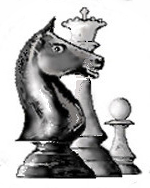 | CCLA Correspondence Chess |
| Copyright © 2005– by CCLA. All rights reserved. |
| [top] |
CHESS GLOSSARY | ||
A Dictionary of Chess | ||
Terms which appear as links (blue) will be underlined when the mouse passes over them. If clicked,
these will take you to our relevant standard tactics or checkmate pages. | ||
| B | J | R |
| C | K | S |
| D | L | T |
| E | M | U |
| F | N | V |
| G | O | W |
| H | P | X |
| I | Q | Z |
| [top] |
A |
absolute pin - when a piece shields the king from direct attack by an enemy queen, rook or bishop, that piece is immobilized in an absolute pin. The pinned piece may not move because the rules of chess prohibit a player from putting his own king into check. |
Adjudicate (the formal process of adjudication) - Adjudication is a formal process by which the final position of an unfinished game is analyzed by an unbiased third party, who then declares that position a win for one player or else drawn. In over-the-board events, adjudication is sometimes necessary in order to make pairings for the next round, as well as establishing prize winners after the final round of play. In correspondence events, adjudication occurs when the time allowed for play has expired, so that winners can be determined and the awarding of prizes can occur in timely fashion. Sometimes the TD's decision is final; other times, the adjudication may be appealed. In some instances, the evaluation is based on specific analysis leading to a definitive conclusion, i.e., forced mate, forced draw or "won ending" whose technique is documented in the literature. In others, definitive analysis is not possible and the adjudicator must rely on general principles. Here he will usually award a win for material advantage but not for "positional" advantage alone. |
"Advanced Chess" - chess played by correspondence in which the use of chess engines to aid in selection of moves is permitted by the tournament rules (see also "computers", "chess engines", "Draw Death of Chess", and Advanced Chess - Hints To Get Started.) |
advanced pawn - a player's pawn located in the opponent's half the board. Such pawns, supported by pieces and especially by pawns, control space and therefore help limit the opponent's mobility. Because they cannot retreat, advanced pawns without adequate support may be lost and so every pawn push must be carefully considered (see "pawn chain," "salient.") |
advanced piece - a player's piece located in the opponent's half the board. When supported by another piece or pawn, such pieces are not easily driven off and exert a cramping influence because they attack and may control squares behind enemy lines. Advanced pieces are often the keys to combinations and mating attacks. The opponent will likely attempt to drive-off or exchange an advanced enemy piece (see "outpost," "over-protection.") |
advanced square - any square in the opponent's half the board which your forces occupy and/or control is an advanced square (see "outpost," "space.") |
advantage - the player with superiority in one or more of the elements is said to have the advantage. An advantage in force and/or (opponent's) disadvantage in king safety will normally lead to an attack. The player with an advantage in other elements (space, time, pawn structure) will attempt to convert these into victory through a combination of technical knowledge and experience. An advantage in force or pawn strucure tends to be long-lasting, often permanent, while an advantage in space or time is usually transitory (see "analysis of position", "technique," "edge".) |
Alekhine's Gun - the arrangement of two Rooks backed-up by the Queen on an open or semi-open file, a winning motif used by Alekhine to defeat Nimzovich at San Remo, 1930. See battery |
Algebraic Notation (AN) - The notation system first promoted by Philip Stamma for recording the moves of a game based
on letter / number coordinates. In algebraic notation, each square of the chessboard has a unique "letter / number" identity. For example, the square in
the top left corner is "a8", the square in the lower right corner is "h1" (see also figurine algebraic notation.) |
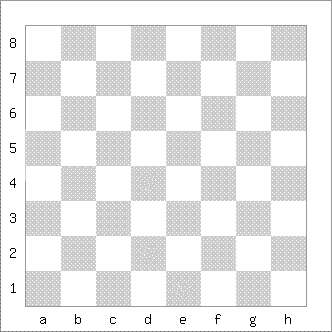 |
For a detailed explanation see Chess Notation. |
analysis of position - the systematic evaluation of a position, to determine which side holds an advantage, and of what element(s) this advantage consists. This is necessary to determine (a) the immediate tactical situation and (b) a long-term strategy. In general, an advantage in force or pawn structure tends to be permanent and indicates endgame play. An advantage in time or space is usually transitory and is best exploited in a middlegame. The remaining element, king safety, must of course receive primary focus. If the opponent has weakened his king's position, an attack on the king (if possible) should be considered before evaluating general features of the position. |
Anastasia's Mate - the checkmate
pattern involving a King in the corner, its flight square blocked by its own pawn or controlled by the enemy knight, and attacked by a rook. In
the diagram below, Black's king could also stand on h7 with the same result. |
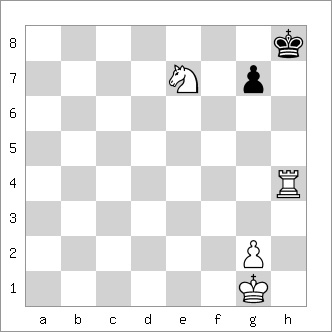 |
Anderssen's Mate - the checkmate
pattern named after German master Adolf Anderssen (1818-1879), involving a King on the backrank checked by a rook protected by a pawn of
its own color. Some authors include either heavy piece, rook or queen, and also include positions where a bishop protects the checking piece from
any square on the long diagonal. |
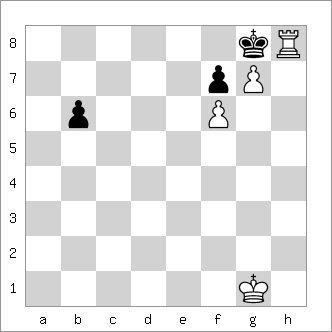 |
annotation - textual comments and symbols that often accompany the moves of published chess games, designed to instruct and explain the reasons for the moves, to give alternative variations and to site references. Sometimes annotations are by the player(s), other times by independent analysts. Most chess engines are capable of annotating games, although the public dislikes machine-generated comments since phraseology tends to be repetitive and analysis cursory. |
anti-positional - moves that are not in accord with the tenets of "position play." Anti-positional moves are often made because the player believes the short-term good will outweigh the self-inflicted long-term weakness (see "positional chess.") When such moves succeed, they are called genius, but if they fail, the moves are labeled anti-positional, or worse! |
Arabian Mate - the checkmate
pattern involving a King trapped in the corner, checked by a rook protected by a knight of its own color. |
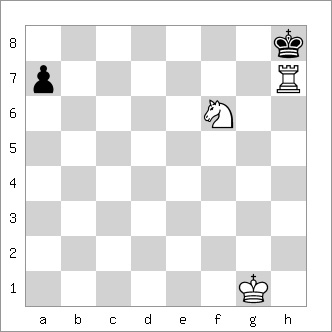 |
artificial castling see "castling by hand." |
attack - moving a piece or pawn so it threatens to control a square, capture an enemy unit or "check" a king (see also mating attack.) Beginners often have difficulty distinguishing between attacking (threatening) versus actually controlling a square. |
attraction - a tactic where a player entices a piece (often by sacrifice) onto a square where it can be attacked in the future. It is the opposite of deflection (luring a defender away from a key square) because the objective is to lure the enemy piece toward a targeted or desired square. |
| [top] |
B |
Back Rank Mate - checkmate by queen or
rook of a king on the first or eighth ranks, trapped behind a "wall" of pawns and/or pieces. Some authors prefer "Corridor Mate," as the mate
can be effected on any rank or file, not just the back rank. |
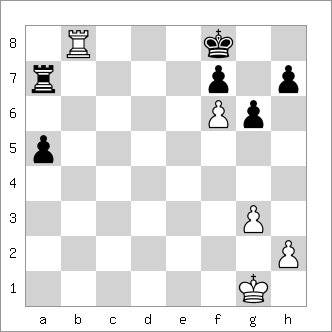 |
backward pawn - a pawn that can no longer be protected by an adjacent pawn is said to be backward and constitutes a serious flaw in a pawn formation. Such pawns are especially vulnerable if they sit on a half-open file, exposed to frontal assault by enemy forces. Even if not on an open file, the square in front of a backward pawn is called a hole and is usually weak because it invites occupation by an enemy piece. |
bad bishop - a bishop hemmed in behind pawns of its own color, its mobility greatly diminished. Often referred to as a "problem bishop" (see also "spectator".) |
basic checkmates - the four fundamental checkmates of the game, characterized by greatly simplified positions with no pawns, just the kings and some other piece(s.) These checkmates are all forced wins for the superior side, meaning that even with best play by the defender the superior side can force checkmate. The four basic checkmates are K+Q vs. K, K+R vs. K, K+ 2B's vs. K and K+B+N vs. K. Note: K + 2N's vs. K is a draw; although the knights can checkmate, they cannot do so by force. |
battery - the queueing up of queen and/or rook(s) on a file, half-open file or rank, or queen and bishop on a diagonal, to (1) overwhelm an enemy weakness by force, or to (2) create a double attack by moving the intermediate piece. This motif, featured in the famous game Alekhine-Nimzovich, San Remo 1930, came to be known as Alekhine's Gun. |
better King position - in simplified endings (few if any pieces remaining,) the King closest to its passed pawn or potential passed pawn is said to have the better position. A centralized King will be "better" than one buried in a corner, or castled on the wing opposite the opponent's pawn majority. Better King position is often a winning endgame advantage. |
bind - In chess, having a bind means the opponent's pieces lack mobility and he is unable to answer all your threats. A player in a bind will often suffer loss of material and/or further weakening of his position. Being caught "in a bind" is usually associated with a cramped position, i.e., a lack of space or time to maneuver (see also "initiative.") |
|
bishop pair (the "two bishops") - Since they can attack all the squares on the board from a distance, a pair of bishops (as opposed to bishop and knight, or two knights) is considered a positional advantage. While this is certainly true in open positions, in closed or blockaded positions a knight can be more effective than a bishop. The two bishops are a force to be reckoned with, however, often effecting checkmate in the middlegame as well as the ending (see also " minor exchange".) |
Black - term given to the player who has the black or dark-colored chessmen. |
Blackburne's Mate - the checkmate
pattern named after English master Joseph Henry Blackburne (1841 - 1924), involving a King on the back rank attacked by three minor pieces.
|
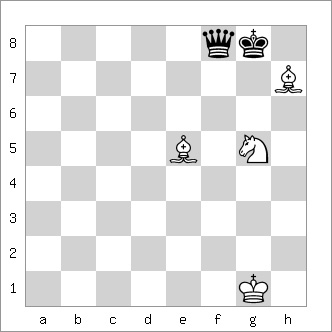 |
blindfold chess - (French "sans voir") games conducted where one or both players do not have sight of the board and men and must hold positions in memory. Moves are communicated by third parties who also make the physical moves on the chessboard. A blindfolded master giving a simultaneous exhibition against multiple opponents is always a spectator favorite. |
blitz (German "lightning") - fast play or "speed chess". |
blockade - the placement of a piece or pawn directly in front of a pawn to halt it's forward movement (see "stop square".) The concept of the blockade ("Die Blockade" in German) figured prominently in Nimzovich's theories. |
blocked position - a position in which neither side can make a break through, due to interlocking pawn chains and/or crippled pawns (see closed game, pawn chain, pawn break.) |
blocking - the tactic of breaking an enemy piece's line of attack by interposing a piece or pawn. Blocking also applies to situations where pieces of the same color hinder each other's movement. An example would be Smothered Mate, where other pieces of the same color prevent the king from escaping a check (see Smothered Mate). |
blunder - a weak move that spoils a position, such as losing material without compensation, or stumbling into a mating net. |
board (chessboard) - is the square surface upon which a game of chess is conducted. It consists of 8 rows and 8 columns, thus dividing the chessboard into 64 squares of alternating color. Chess boards acceptable for tournament play may be made of any material that is wood-grained or green and eggshell, colors that create the least amount of eye strain during hours of staring at the board. FIDE's Rules of Chess also specify the minimum height of the pieces and minimum size of the squares of the board. (Hint: do NOT bring a red and black checker board to a chess tournament.) |
Boden's Mate - the checkmate
pattern named after English master and artist Samuel Boden (1826 - 1882), involving a King castled queenside, attacked by two bishops.
Some sort of sacrifice is usually required to disperse the q-side pawns. |
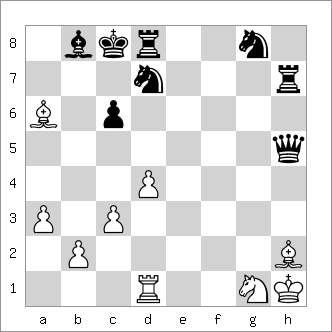 |
"book" - two opponents are "playing book" when their opening moves follow published theory. For deviations from book, see blunder and theoretical novelty. A "book win" is an endgame where the winning technique is documented in endgame literature. Similarly, a "book draw" is an endgame where the drawing technique is documented in the literature. |
"book draw" - a position, documented in endgame literature, which leads to a draw with best play on both sides. Sometimes referred to as a "theoretical draw" (see also "tablebase.") |
"book opening" - a sequence of opening moves which follows published analysis (see "opening theory", "ECO".) |
"book win" - a position, documented in endgame literature, which leads to a win even with best play by the defender (see also "tablebase.") |
break (break-through) - A pawn advance, to be followed by a pawn capture that opens a blocked position. Much of chess strategy involves the attacking side trying to engineer such a break-through, the defender trying to prevent it. In his book Pawn Power in Chess, Hans Kmoch called such pawn breaks "levers" because such moves tend to "pry open" a blocked position (see "lever," "pawn break.") |
bridge ("building a bridge") - when an enemy rook or queen prevents a king from entering a rank or file, moving a piece next to the king, but on that rank or file, severs the enemy piece's line of attack and enables the king to "cross over." Nimzovich was the first to name this concept, now a standard technique in many positions and the essence of the Lucena endgame strategy (see also "blocking", "interference", "Lucena position.") |
bust - in the opening, a "bust" is a refutation, as in Bobby Fischer's famous article entitled "A Bust to the King's Gambit" (which turned out to be no bust at all.) Players who find themselves in a lost position are also said to be "busted." |
| [top] |
C |
Caissa - the legendary goddess of chess. |
calculation - the projection of a forced, or else most likely to occur, sequence of moves. Accurate calculation is critical in estimating the success of a combination or a mating attack, especially where sacrifice is involved. Lengthy calculation is also required in endgame play (see vizualization.) |
candidate first - the rule states when a pawn majority moves against a pawn minority, the pawn not blocked by an opposing pawn should be advanced first. A candidate pawn is a potential passer. |
candidate move(s) - an initial or "first pass" analysis of a position should produce one or more candidate moves, each of which should be investigated in greater depth. Eventually, a player will narrow the field down to one "best" move. |
capture - in chess, capturing is only done by displacement: the enemy piece or pawn is removed from the board and replaced by the capturing unit. The knight is the only piece that may jump over other chessmen, either those of its own color or those of the enemy, but the knight does not capture pieces or pawns that it jumps over; only the enemy piece or pawn that occupies its landing square is captured by the knight. |
castling (to castle) - Castling is a maneuver in which the king and a rook are both moved; although two
pieces are involved, the maneuver counts as one move or turn. Castling may be done to either side of the board and is commonly referred to as
"king-side castling" (pgn notation symbol "O-O") or "short-side castling," and "queen-side castling" (pgn notation symbol "O-O-O") or "long-side
castling", referencing the initial position. Castling is done correctly by moving the king first, two squares to the left or right, then placing
the rook next to the king on the opposite side (see "touch move rule.") |
castling "by hand" - several individual moves by the king and a rook, so they are positioned approximately as if they had castled normally. Sometimes referred to as "artificial castling". A player must have an otherwise secure position, or his opponent's position must be ineffective, to afford the tempi lost in castling "by hand." It occurs most often when queens are exchanged in the opening; one side must recapture with the king, thus forfeiting his right to castle normally. Castling "by hand" gets the vulnerable king away from the center of the board. |
"castling into it" - occurs when a player overlooks or under-estimates the strength of an opponent's potential attack on that wing. Players who have "castled into it" often realize too late they have placed their king in more danger by castling than if they'd played some other move. |
cc - the standard abbreviation for "correspondence chess." |
|
center (the center) - the four central squares of the chessboard: d4, d5, e4, e5.
Control of these squares is a major objective of correct opening play (see also "extended center".) When both sides play well, neither side can
monopolize the entire center. The importance of center control extends into the middle game and sometimes even into the ending. |
center fork trick - a temporary sacrifice of a piece in certain openings such as C46, the Four Knights Variation. A pawn fork recovers the piece with a slightly better center; center pawn on its 4th rank vs. center pawn on its 3rd rank is a plus in positional evaluation. It can be played by White (1.e4 e5 2.Nf3 Nc6 3.Nc3 Bc5 4.Nxe5 Nxe5 5.d4 Bd6 6.dxe5 Bxe5 7.Bd3) or Black (1. e4 e5 2. Nf3 Nc6 3.Nc3 Nf6 4.Bc4 Nxe4 5.Nxe4 d5 6.Bd3 dxe4 7.Bxe4 etc.) |
"centipawn" - 1/100 of a pawn, the unit of valuation used in computer programs that play chess and analyze positions. Human players cannot differentiate such minute differences, although experienced Grandmasters can assess the positional considerations of some positions as worth "a half a pawn." |
centralization - is a major tenet in Nimzovich's theories. Placing pieces and pawns where they occupy and/or influence the battle for control of the center squares is centralization. A fuller explanation of this concept can be found in CCLA's Fight for the Center ! article. |
cheapo (cheap shot) - a dubious move that has the appearance of a strong threat, sometimes succeeding due to the opponent's "chess blindness," inattention or time pressure (see "swindle", "trap.") |
check - an attack on the king. The rules of chess require the player whose king is "in check" to get his king out of check immediately (very next move.) Getting one's king out of check takes priority over all else. There are three ways a king can get out of check: capture the unit giving check, interpose a piece to block the line of attack or else move the king out of the line of attack. Interposing a piece is not possible when a knight or a pawn checks a King; capturing the attacker or moving the King are the only options. Likewise, interposing is not an option when the King attacks another piece. The pgn notation symbol for check is "+". |
checkmate (mate) - When a king is in check and has no legal move to get out of check, it is said to be checkmated and the game is lost. Checkmate can be abbreviated as "mate," as in a chess problem captioned "mate-in-three," which also must identify which side has the move. The standard pgn notation symbol for checkmate is "#" (see mating attack). |
chess - an ancient board game of strategy, played by two persons with a specialized set of game pieces and specific rules. |
chess blindness - (from the Latin "amaurosis scacchistica") - meaning the over-looking of simple threats (see "blunder.") |
chess engine - term applied to various software programs which can actually play chess as well as analyze single positions and / or complete games with great accuracy. Human players can no longer defeat chess engines. Some of the leading engines today are Fritz, Rybka, Houdini, Hiarcs, Komodo, Stockfish and the new Leela Chess Zero, the first engine created using AI (artificial intelligence) learning techniques (see "advanced chess".) |
chessmen - the collective name for a chess set, 16 white pieces and 16 black pieces. There are six different kinds of pieces: king, queen, bishop, knight, rook and pawn. At the start of the game, each side has one king, one queen, two bishops, two knights, two rooks and eight pawns (see "initial position," "Staunton pattern.") |
"chopping wood" - chess jargon for exchanging multiple pieces, from the old days when chess sets were made primarily from wood. |
CJA - The Chess Journalists of America encourage chess journalists and writers, editors and publishers, and creators and producers of digital media to exchange information and ideas for their mutual benefit. We promote the highest standards of ethics in chess journalism, represent United States chess journalists in appropriate national and international bodies, and influence policies affecting the promotion of chess. |
classical chess - especially white's opening play, the establishment of a d4/e4 pawn center and centralized development of the pieces to support that pawn center. Classical opening strategy is center control by occupation of those squares with pawns and centralization of the pieces (compare "hypermodern chess.") |
clearance (sacrifice) - the tactic of moving, often sacrificing a piece or pawn to remove it from a square, or line of squares, needed for an attack by other pieces. |
closed file - a file which neither side can access with rooks or queen because of blocked pawns. Sometimes a closed file can be opened by means of pawn exchanges or a piece sacrifice. Similarly, the defending player may close a file by means of exchanges or sacrifice. |
closed game - Openings which begin 1.d4, d5 are classified as closed openings. Positions tend to remain closed because white's pawn levers (c4 or e4) are more difficult to enforce and black has time to defend (compare open game, semi-closed and flank openings.) |
closed position - position in which the center pawns are blockaded; therefore, play will shift to the wings. |
combinations - a sequence of planned moves designed to attain an objective by force. Some authors insist that sacrifice must be part of the definition, calling a sequence of moves without sacrifice a maneuver. Combinations can be simple or complex and are composed of one or more standard tactical motifs (see tactics.) |
compensation - the non-material (positional) factors a player hopes will make-up for loss or sacrifice of material. Examples might be gain of tempo, better development, the weakening of the opponent's pawn structure or gaining control of more space (see positional elements.) |
composition - the creation of chess studies and problems which can range from mundane diagrams for instructional articles and books to the highest art form. There are international competitions and even titles awarded to chess enthusiasts who excel in this field (see also "cook", "puzzle," "solver.") |
compromised king-side - is when the original pawn wall in front of a castled king has been weakened through pawn exchanges, loss of a fianchettoed bishop or pawn advances. Castling king-side occurs much more frequently than queen-side castling; queen-side pawns can become compromised as well, plus the a-pawn and a1 (or a8) square are undefended after queenside castling. |
computer (chess engine) - a computer program that plays and analyzes chess is called a chess engine. Unlike primitive efforts of the mid 1900's, running first on mainframes, then on stand alone sensory boards and eventually on desktop machines, today's top chess engines run on handheld devices, perform at grandmaster level and easily defeat the world's strongest players, even world champions. |
connected passed pawns - two passed pawns on adjacent files that can support one another diagonally are said to be connected. They are especially strong in the end game and can hold an enemy king at bay all by themselves; if the king captures the rear pawn the forward pawn will reach its promotion square. |
consolidation - the process of "fine tuning" a favorable position. A player may seek to trade-off or relocate pieces to better squares, repair (if possible) weakness in his pawn structure or take steps to limit the opponent's counter-play. |
control (of squares) - Control of a square means a player can place his pawn on this square without losing material, or can place a piece there without losing material or being forced to retreat. Sometimes squares are occupied by pieces or pawns, sometimes pawns and pieces are placed so that the opponent cannot occupy one or more squares. Some squares cannot be held by either side, while others are under a constant state of siege, with both sides maneuvering to gain control. It's not often that a square, once controlled, remains that way for the duration of the game, because the opponent will likely be maneuvering to wrest control of the square away from its owner or, failing in that, to exchange or at least neutralize the effectiveness of an enemy piece posted there. From the desire to maintain control of key squares comes Nimzovich's theory of "overprotection". |
control of the center - the four squares (sixteen squares in the extended center) in the center of the board are of the utmost strategic importance in chess. Through the center is the shortest route for one's pieces to maneuver, for attack or defense. The player who controls more of the center has a positional advantage. See also the Fight for the Center! article. |
cook - a "cook" is an unanticipated move or variation that spoils a chess problem or composition. In actual games, we call a failed mating attack or a spoiled combination due to an unanticipated defensive move an oversight or a blunder, depending on the seriousness of the outcome. |
correspondence chess - games that are not conducted by face-to-face opponents. Correspondence games were conducted via mail, telegraph and short-wave radio before the internet. Play via email was popular in the early days of the internet, but has now been eclipsed by server chess, with moves exchanged on a web server. Today, correspondence play is dominated by server chess. |
corresponding squares - the occupation of such squares results in reciprocal zugzwang. If Black's king is on the d6 square, then White's king needs to be on the d4 square; each king thus prevents the other king's advance. d4 and d6 are corresponding squares. This is a simple example; the theory of corresponding squares is much more complex and explanations can be found in advanced publications on king and pawn endings. |
counter-attack - when a player chooses to react aggressively with his own attack, instead of defending against a threat, it is called a counter-attack. Counter-attacks may begin immediately, or be delayed until the original attack has been repulsed. |
counter-gambit - when Black offers an opening gambit it is called a counter-gambit. Some well-known examples are the Albin Counter-Gambit, the Falkbeer Counter-Gambit and the Greco Counter-Gambit (Latvian Gambit.) |
counter-play - A player whose position offers active play (as opposed to passive defense) as compensation for an opponent's advantage elsewhere on the board is said to have counter-play. |
counting (squares) - (a) In the endgame, counting squares means determining how many moves
are needed for a pawn to reach the 8th rank and be promoted. Where both sides have a passer, the square count becomes critical in the decision
to push the pawn or try to stop the enemy pawn, or perhaps in the decision to maneuver to a more favorable count before exchanging pieces
(see also "pawn race," "simplification"). |
cramped position - the side which lacks space to develop or maneuver its forces is said to have a cramped position. A space deficit usually results from allowing the opponent to establish too many advanced pawns and/or outposts. "Cramped positions bear the germs of defeat." — Dr. Siegbert Tarrasch (1862-1934.) (see "space".) |
crippled pawn majority - is one where a numerical superiority of pawns on a wing is unable to create a passed pawn due to structural weaknesses such as doubled, backward or isolated pawns. |
cross check - when a piece blocks a check and simultaneously creates a check on the opposing king, it is called a cross check. The blocking piece may itself also give check, or the movement of the blocking piece may "discover" (uncover) a check from another piece. |
| [top] |
D |
Damiano's Mate - the checkmate
named after the Portuguese player and chess author Pedro Damiano (1480-1544), involving a King on the back rank attacked by a queen
protected by a pawn of its own color. |
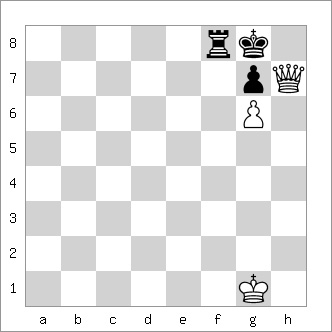 |
Damiano's Bishop Mate - the checkmate
involving a King on the back rank attacked by a queen protected by a bishop of its own color. |
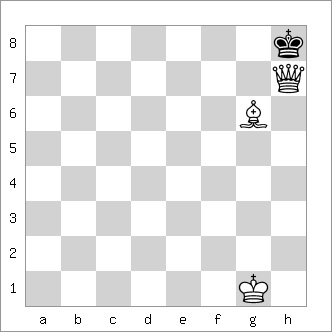 |
dark-square bishop - the bishop placed on a dark square in the initial position. |
dark-square weakness - the inability to control a group of dark squares, usually due to loss or exchange of one's dark-square bishop and/or pawn chains on light squares. Hans Kmoch named this condition "melanpenia" in his Pawn Power in Chess (1959). |
database - a collection of chess games, usually in pgn or cbf format, available online or on dvd. Databases can be researched efficiently with software ("readers") designed specifically for that purose. Because pgn databases can also be edited in commonly available word processing programs such as Wordpad or Notepad, players can also create custom databases for opening variations, their own chess games, etc. (see also "pgn", "opening preparation".) |
David and Goliath Mate - the checkmate
involving a King checkmated by an enemy pawn. Mate can occur "anywhere" on the chessboard (but subject to the restrictions inherent in
the way a pawn moves and captures.) |
 |
decoy - a piece or pawn moved, frequently offered as a sacrifice, to draw a defender onto a target square (see also deflection, distraction.) |
defend - to move a pawn or piece so that it escapes an attack or a threat by the opponent, or to move another piece or pawn so that it protects the attacked/threatened unit. Sometimes a unit under attack can be defended indirectly, i.e., by attacking an enemy piece of higher value elsewhere on the board. Veteran players do not wait for an opponent's attack and then decide how to defend; they anticipate threats and play to prevent or discourage an opponent's attacks (see "over protection".) |
deflection - the tactic of causing an enemy piece to move away from a key square, often accomplished by a sacrifice. The term is synonymous with distraction (see also "decoy".) |
"Descriptive Diehard" - a pejorative term applied to "old school" players who resisted the change to algebraic notation in the 1970's. |
Descriptive Notation (or DN) - a system of notation in which the pieces (including the pawns) have designated letter symbols, the files of the chessboard are named for the pieces in the initial or starting position and squares are numbered from the side having the move. DN was the dominant notation system until the 1970's and a universal switch to Algebraic Notation. |
desperado - a trapped piece. Because it cannot escape or be adequately defended, a desperado sacrifices itself (a) for as much material as possible, or (b) to create a weakness in the enemy position. |
development - the process of moving as few pawns as possible to bring the knights, bishops and queen from the back rank onto squares that influence the fight for center control, and castling to protect the king behind a wall of pawns. |
diagonal - a straight line of squares of the same color is a diagonal on the chessboard. |
discovered attack - when moved, a piece which masked an attack on an enemy piece is said to create a discovered attack. If the discovering piece also attacks something, then the situation is a double attack. |
discovered check - when moved, a piece which masked an attack on the enemy king is said to "discover" a check. This type of check is very dangerous because the defender is obliged to get his king out of check and cannot defend against whatever new threat the discovering piece may create. If the discovering piece also gives check, the situation is a double check and the king's only possible defense is to move out of check (which may include capturing one of the attackers.) |
direct opposition - two kings separated by one square on a rank, file or diagonal. |
distant opposition - applies to K+P vs K endgame positions where the kings are separated by 2 or more squares on a rank or file. If there are an even number of squares between them, the side on the move has the opposition. If there are an odd number of squares between them, the side on the move does not have the opposition. Exception: if there is a pawn on the same rank as a king, or on one of the ranks between the two kings, the strategy of maintaining distant opposition does not work (see also the opposition, magic square, triangulation, zugzwang.) |
distraction - the tactic of causing an enemy piece to move away from a key square, often accomplished by means of a sacrifice. Synonymous with "deflection" (see also "decoy".) |
double attack - movement of a piece or pawn results in two enemy units being attacked simultaneously. All forks are at least double attacks, but not all double attacks are forks. |
double check - a move that results in a king being attacked simultaneously by two different pieces. Double check is very forcing because the king is unable to defend itself by interposing another piece, cannot capture both attackers and so must move out of check. The king may be able to capture one of the pieces giving check, but frequently such a piece is part of a combination. "Even the laziest king flees wildly in the face of a double check!" — Aron Nimzovich (1886 - 1935.) |
doubled pawns - two pawns of the same color on one file. This situation occurs as the result of captures. Doubled pawns are less mobile and more easily blockaded. There may be some compensation in the number of squares they defend, particular if they occur at or near the center. Isolated doubled pawns have no pawns of the same color on the adjacent files; these are extremely vulnerable to attack and blockade, must be defended by other pieces and are a liability in the end game. |
doubled rooks - two rooks of the same color on the same file or rank are said to be "doubled" (see also battery.) "Rooks (doubled) on the 7th rank" are almost always a winning advantage. Sometimes referred to as "connected" rooks. |
Dovetail Mate - the checkmate
involving a King attacked by a queen protected by another piece; the king's flight squares are occupied by its own forces, the pattern said to
resemble a dove's tail. This mate can occur anywhere on the chessboard. |
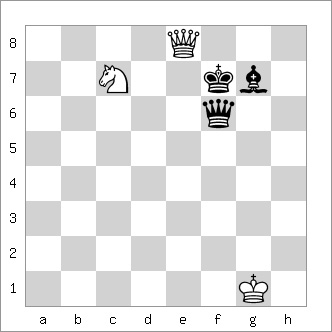 |
draw (drawn game) - result is scored 1/2 point for each player. There are 5 ways a chess game may be drawn: |
draw death of chess - originally, a theory that perfectly played games will always end in draws. Capablanca and Fischer
even went so far as to propose new forms of chess;
"Capablanca Chess," with a larger board and two new pieces did not catch on, but "Fischer Random Chess" or "Chess960" is still a popular variant.
The format Fischer promoted (but did not invent) was formerly known as shuffle chess, where the pieces are randomly placed on the bank ranks at the
start of the game. This variant also requires a couple modifications to the rules of chess. The "960" in Chess960 alledgedly refers to the number of possible
starting positions; these are chosen randomly in official Chess960 tournaments. Chess960 takes away the modern player's dependency on (1) memorized
opening theory and (2) special preparation, often involving seconds and/or teams of analysts, for match opponents. |
drawing line - Any one of several opening variations that typically result in a draw. Players use these to produce quick results, giving themselves a rest period between rounds of a lengthy tournament. Players also utilize these when faced with a stronger opponent, hoping to avoid a loss. Strong players also find ways to avoid them. Drawing lines must be constantly updated as opening fashion changes. |
| [top] |
E |
ECO (Encyclopedia of Chess Openings) - a multi-volume work on the chess openings. ECO codes classify all chess openings according to an alphanumeric (letter plus two numbers) system, ranging from A00 to E99, and are widely used in online databases and game collections. ECO codes have largely replaced traditional descriptive names of the openings, such as Reti Opening (ECO "A10") or Scotch Game (ECO "C45"). Major openings like the Sicilian Defense (ECO "B20 - B99") occupy an extensive range of codes. |
edge - the player with an "edge" holds a superiority in material and/or position (see also "advantage", "bind.") |
elements - According to GM Larry Evans in his book New Ideas in Chess (yes, the same title as Richard Reti's earlier work) the main elements of chess are force, space, time, pawn structure and king safety. A discussion of the "elements of position play" would involve delving into these five categories in much greater detail, several dozen topics requiring detailed examples (see "positional elements.") |
end game or ending - An end game usually presents a somewhat simplified position, with fewer pieces and pawns due to previous exchanges. The kings become active pieces, especially in positions without queens where there is less danger of a mating attack. End games also have strategy and tactics; pawn promotion is the objective of some end games, while direct assault on the king is featured in others. Many end game positions are recurring and have their own published theory, making them amenable to study and to extraction of principles which a player can apply to similar positions. |
engine ("chess engine") - A computer program designed to play and analyze the game of chess. Programs were originally written to run on mainframe computers, then adapted for "stand alone" micro devices and, with the advent of the pc, as portable software ("apps") for computers, tablets and smart phones. There is a great deal of "hype" concerning who produces the "best" chess engine today. What most players fail to grasp is the performance of any chess engine is greatly influenced by the hardware on which it is running, particularly the speed and number of processors and amount of physical memory installed in their machines (see Advanced Chess for an in-depth look at chess engine analysis.) |
engine detection - Organizations which disallow use of chess engines in the selection of moves in live games have found it necessary to implement detection systems to prevent engine abuse. OTB organizations use statistical methods, as well as preventive methods while games are in play on site. Online server "admins" tend to keep their methods secret, but likely include checking response times in server logs as well as analysis of game moves. The correspondence chess organizations examine completed game scores using some form of statistical analysis (see "Top 3".) |
en passant - (French "in passing"), is abbreviated e.p. in descriptive notation. If a player's pawn is on the 5th rank, and the opponent moves an adjacent pawn to the 4th rank, the first player has the option of capturing that pawn en passant (just as though it had only moved to the 3rd rank.) The option must be exercised immediately (next move) and cannot be deferred. On subsequent moves, the pawn which has made an en passant capture continues to move forward on its new file. |
en prise - (French "within grasp") term applied to a threatened piece or pawn left "hanging" (unprotected) and liable to capture (see also "attraction", "deflection" and "decoy" sacrifices). |
| [top] |
|
Epaulette Mate - (French "little shoulder") The
epaulette mate is a checkmate pattern where a King is attacked by a queen and blocked on each side by its own pieces, such as the rooks,
said to resemble the shoulder decorations on a military dress uniform. |
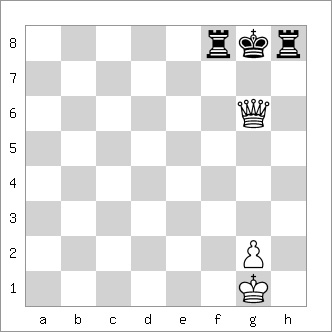 |
equality (equalibrium) - may be a static situation on the chessboard where neither side has a material advantage or an advantage in position; routine, safe play will almost certainly result in a draw. A player determined to avoid a draw will often adopt a risky strategy (aka "create complications") to upset the equalibrium and create winning chances. The term is more commonly used to describe positions which have dynamic equality, where one side has a plus in some elements and the other side has advantage in other factors, thus "equal chances;" pgn notation symbol is "=". |
equalize - a player is said to have "equalized" when the opponent's advantage has been nullified; usually said of Black after the opening moves, when the resulting position is said to be "even" or offering "even chances" (see "equilibrium.") |
escape square - a square on which a piece may move to avoid capture or, in the case of a king, move out of check. Players often create an escape square by moving one of the pawns in front of a castled king, a stratagem known by the German term "luft" (air.) "Luft" can be a double-edged strategy, as pawns advanced from the castled position can themselves become objects of attack. |
exchange ("the exchange") - the decision to exchange (a capture followed by a recapture) one unit for another is normally guided by the table of relative values, i.e., a bishop for a knight is considered an "even" exchange. When a player obtains a rook for a knight or bishop, he is said to win "the exchange." Some authors refer to exchanging knight for enemy bishop as winning "the minor exchange." (see also "value".) Advanced players have learned to evaluate the subtle differences in the present and future mobility of the minor pieces in a particular position; their exchanges, or avoidance of same, are based more on positional considerations than on a theoretical table of values. |
extended (expanded) center - the sixteen central squares of the chessboard: c3, c4, c5, c6, d3, d4, d5, d6, e3, e4, e5, e6, f3, f4, f5, f6. |
extended fianchetto - development of a fianchettoed bishop to the 3rd rank is called an "extended fianchetto" (see fianchetto.) |
| [top] |
F |
FAN - abbreviation for Figurine Algebraic Notation, which utilizes chess fonts to replace the letters for chess pieces (K,Q,B,N,R) with chess symbols for these pieces, white and black. The chess symbol for pawn is needed for chess diagrams but is not used in algebraic notation of gamescores. |
FEN (Forsyth-Edwards Notation) - standardized, shorthand description of a chess position using letters, numbers and symbols. Players
sometimes use this to write-down a position due to adjournment. FEN notation is also used by chess software to search databases, or create diagrams for publication in
printed media or on web pages. The following is the FEN notatin for the starting position of a chess game: |
fianchetto (Italian "side" or "flank") - development of a bishop onto a long diagonal via b3 and Bb2, or g3 and Bg2 for White, or ... b6 and ... Bb7, or ... g6 and ... Bg7 for Black. The loss or exchange of a fianchettoed bishop often results in a weak square complex (see also "extended fianchetto".) |
F.I.D.E. (Federation Internationale des Echecs) (French "World Chess Federation") - the world governing body of organized chess. The national organizations of all the countries of the world are FIDE affiliates. The correspondence chess branch of FIDE is the ICCF (International Correspondence Chess Federation.) FIDE awards all international titles, administers the rules of official competition and organizes the World Chess Championships for men, women and juniors. |
fifty-move rule - one of the five ways a chess game may be drawn. If fifty consecutive moves have been played where neither player has moved a pawn or captured a piece, the game will be declared drawn if a player so claims (see drawn game.) |
figurine algebraic - algebraic notation system which uses chess fonts (chess diagram symbols for pieces and pawns,) substituting them for the English letters K,Q,R,B,N,P. Publishers use chess fonts to make gamescores in chess books, magazines, web pages and blogs understandable in all languages (see Algebraic Notation.) |
 |
Typical font used in chess diagrams |
file - a vertical line of squares. In Algebraic Notation, starting from white's left, the files are named a - h. |
"fingerfehler" (German for "finger error") - a blunder from touching the wrong piece or releasing a piece (completing the move) on the wrong square (see "touch-move rule.") |
first-move advantage - having the first move is considered a theoretical advantage. Game results have borne this out, with White traditionally winning 10-12% more games than Black (and about 25% of games were drawn.) ICCF world correspondence championship compettion, which is advanced chess (engine-assisted play), clearly supports White's first-move advantage: although 90% of these games are now drawn, the rest of the games are almost all won by White! Black won 3 (2%) out of 136 games played in each of the 27th and 28th World Correspondence Chess Championships. In the current (29th) Champ., Black has 1 win out of 111 games completed. The first-move advantage is the reason chess matches between two opponents are always an even number of games so that each player gets an equal number of whites and blacks. In open tournaments, organizers cannot guarantee such a balance due to odd numbers of rounds, drop-outs, byes, higher-priority pairing considerations and so forth but they do try to distribute color assignments as equitably as possible. |
flank - the outer three files away from the central files, i.e., the a-c and f-h files. |
flank openings - openings whose first move(s) involve the movement of flank pawns and/or knights. Examples would be the King's Fianchetto Opening: 1.g3 Nf6 2.Bg2 etc., the English Opening: 1.c4 e5 2. Nc3, Bird's Opening: 1.f4 d5 2.Nf3 and the Reti Opening: 1.Nf3 d5 2.c4. Some flank openings retain an independent character on into the middle game, while others transpose into standard d4 or e4 openings. |
flight square - a square on which a piece can escape an attacker, typically in reference to a king. Eliminating the opponent's king's flight squares is, of course, a major consideration in planning a mating attack (see "luft", "escape square.") |
Fool's Mate - A checkmate by bishop
or queen in the early opening that involves an attack on Black's weakened f7 square (or white's f2 square). The fool's mate only occurs as
a result of extremely weak opening play by the loser. |
| Diagram of Fool's Mate |
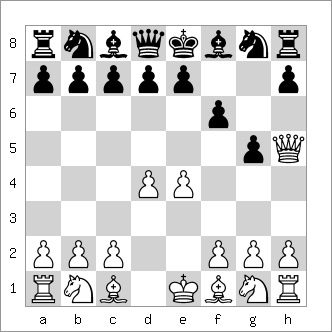 |
force - The concept of force (material) is fundamental to understanding chess; with very few exceptions, superior force wins. The chessmen are the force or material element of chess (see "elements, chessmen") |
forced mate - one or more forcing moves resulting in unavoidable mate (see mating attack, mating net.) |
forced move - the only move an opponent can make to avoid loss of material or checkmate. A forced move may also be the only legal move on the board (see zugzwang.) |
fork - a move after which a piece attacks two or more objectives at once. While we usually think of the "knight fork," any piece or pawn can attack two enemy pieces simultaneously. When a knight attacks three or more enemy units at one time it is called a "family fork". When a knight attacks the enemy king and queen simultaneously it's a "royal fork." |
Although highly unusual, it's possible to achieve both types of knight fork. British master Francis Percival Wenman, himself no stranger to controversy, achieved a "Royal family fork" as the following miniature attests: Latvian Gambit (C40): 1.e4 e5 2.Nf3 f5 3.Nc3 Qf6 4.Nd5 Qf7 5.Nxe5 Qe6 6.Nxc7+ 1-0 Wenman-N.N., Bristol ENG 1938. |
| Royal family fork |
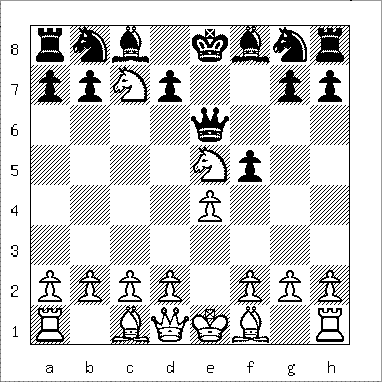 |
fortress - an endgame drawing technique in which the inferior side sets-up a protected area around the king which cannot be penetrated by the opponent's remaining pieces. This technique only succeeds when the opponent does not have a passed pawn, cannot create one or the pawn can be prevented from promoting. The inferior side must also be able to avoid zugzwang positions. Fortress positions can occur in many different types of endings and are another exception to the "rule" that superior force always wins. |
| Fortress Position |
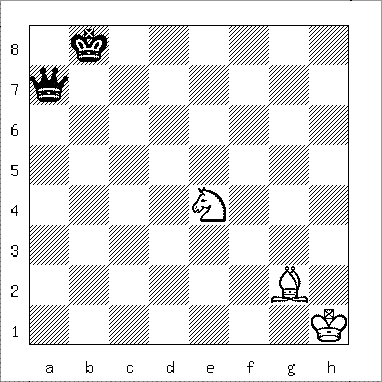 |
| Black to move |
In the diagram above, although Black has a huge material advantage (Q vs B+N) the position is a draw. As long as White doesn't move
knight or bishop, Black's king cannot enter the 3x3 square (f1-f3-h3-h1) to achieve the opposition. No matter how many checks are given by the Black
queen, the White King will never move away from the bishop and so Black cannot win material. If Black persists, the game will be drawn per the
50-move rule or else by threefold repetition of position. |
| [top] |
G |
gambit - (Italian "to trip up"). A gambit is the name given to those chess openings in which one player, usually white,
offers some material, usually a pawn(s) but sometimes a whole piece, to gain an advantage in position. In the opening, such positional factors could be control of more
space, gain of time, better pawn structure and especially an early attack against the enemy king. |
game score - the record of moves played in a chess game. Players in official tournaments are required by the rules to keep an accurate and legible game score. Game scores are often kept on carbonless forms so that a player retains a copy of the game and turns a signed copy in to tournament officials. Today, moves are recorded in algebraic notation. Game scores are published in chess club bulletins, books, magazines, newsletters, newspapers, web pages and blogs. Collections of game scores are available for download in PGN format, often pre-sorted by result, ECO code, tournament, players' names and so forth (see PGN notation, algebraic notation.) |
good bishop - a bishop whose mobility is not restricted by its own pawns. However, its mobility may be limited by an enemy pawn chain on squares of the same color as the bishop. The remedy is well-prepared pawn breaks, to attack and weaken those chains. As the enemy pawns are exchanged or forced to move, squares for the bishop will open up. |
grand variation - a lengthy sequence of opening moves documented in opening theory. Tournament players use them to save time on the clock, playing memorized sequences rapidly without taking time to analyze. Although they are often considered best play for both sides, players run the risk of forgetting moves, inverting proper move order at a critical juncture, or being surprised by a brand new move, a so-called "TN" (theoretical novelty). |
Greco's Mate - A checkmate named
after Italian player and chess author Gioachino Greco (1600-1634) featuring a king trapped in the corner, attacked long-distance by a rook
with an enemy bishop controlling the only flight square. |
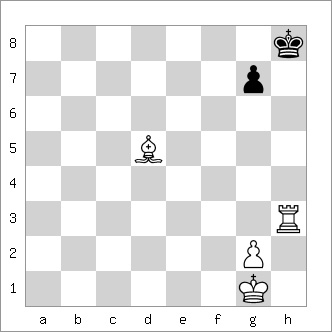 |
Gueridon Mate
(French "small footed table") - a checkmate pattern that resembles a pedestal table with feet. Also known as the swallow's tail mate and the pedestal mate;
some authors insist on treating them separately. |
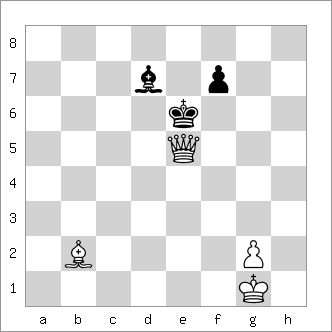 |
| [top] |
H |
half-open file - a file which contains a pawn of one color but no pawn of the opposite color. The file is half-open to the side without a pawn on that file. Half-open files are often occupied by the major pieces (see "battery attack") as they are excellent avenues of direct attack against the enemy pawn formation. A backward pawn on a half-open file is vulnerable to blockade and/or capture, and therefore a positional liability. |
hang - when a player lets a piece "hang" it means the piece is left undefended and liable to capture. Sometimes a hanging piece is the objective of the opponent's combination. Among amateurs, a hanging piece is more likely the result of inattention than a clever trap (see "en prise," "chess blindness".) |
hanging pawns (hanging phalanx) - are a pair of pawns side by side but separated from any other pawns of the same color. Since they cannot be defended by adjacent pawns, they are often targets for attack. Once one of them advances, defended by the other pawn, the rear pawn becomes especially vulnerable. When hanging pawns have thus formed a chain, squares immediately in from of them are likewise weak and make excellent outposts for enemy pieces. Hanging pawns that are not properly restrained are free to advance, often gaining control of much space and providing the basis for an attack (see "pawn storm.") |
heavy pieces - queens and rooks (see "major pieces.") |
hole - a square in a pawn formation that cannot be defended by another pawn. Such squares are vulnerable to occupation by enemy pieces (see also "blockade", "outpost", "outpost square" and "weak square complex".) |
Hook Mate
- a checkmate named because the piece pattern resembles a "j shape" or fisherman's hook. It consists of a king snared by an enemy queen or
rook in close proximity, protected by a knight which is itself protected by a pawn. When these occur away from the edge of the board they are
commonly referred to as "N+R" or "N+Q" mates. |
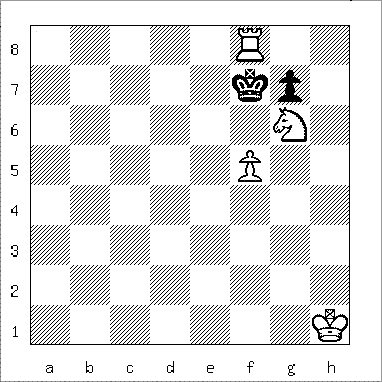 |
hypermodern - strategic concept of controlling the center from the flanks with pieces, rather than occupation of the central squares with pawns. |
hypermodernism - after WWI, a new school of chess developed around the theory that the center could be controlled by piece pressure from the flanks, particularly the fianchetto of one or both bishops, followed by judicious pawn breaks to undermine the enemy pawn center (compare "classical chess.") |
| [top] |
I |
I.C.C.F. - the International Correspondence Chess Federation (ICCF,)founded in 1951, replaced the International Correspondence Chess Association (ICCA, 1945-1951). The original international organization was IFSB (Internationaler Fernschachbund), founded in 1928. IFSB held tournaments among predominantly European players. Today, ICCF is a truly international organization and its titles are recognised as official by F.I.D.E. Such recognition could be in jeopardy in the future, as FIDE has adopted Dr. Kenneth Regan's statistical engine detection (plus on-site electronic surveillance) in an effort to eliminate surreptitious engine use in its otb events (see "draw death of chess".) If games are ICCF-rated then ICCF rules must be followed; games not rated by ICCF may be conducted according to the sponsoring organization's rules of play. |
illegal - A position or move that is impossible because it would violate the Laws of Chess. |
initial position - the alignment of the board and chessmen for the start of a game is defined in the Rules of Chess. |
 |
Queens are placed on their colors, White queen on a light square, Black queen on a dark square.
The lower right-hand square must be a light square. |
initiative - a player is said to have the initiative or momentum when his accumulated threats severely limit the opponent's choice of moves. |
innovation (opening innovation) - The introduction of a new move or variation in a standardized or "book" opening (see also "TN" (theoretical novelty), "opening theory", "book openng".) |
interference - placing a piece so it obstructs the straight-line attack of a Queen, Rook or Bishop. (see also "interpose" and "check".) |
interference (sacrifice) - a tactic in which a piece is sacrificed to interrupt the line of communication between two pieces that defend one another. In order to be successful, the defended object must be more valuable than the piece offered as a sacrifice. |
interpose - placing a piece so it obstructs the line of attack by Queen, Rook or Bishop. Interposing is not possible if the attacker is a knight, king, or pawn. (see also "interference" and "check".) |
isolani (etymology unknown) - term coined by Nimzovich to designate the isolated queen's pawn, abbreviated IQP in the literature. An isolated d-pawn, white's or black's, most often occurs in the Queen's Gambit and related lines, but may arise from other openings as well. Depending upon whether they believe the IQP to be strong or weak, players will happily accept, or play to avoid, an IQP in their own positions. |
|
isolated pawn - a single pawn with no adjacent pawns of its own color for support is said to be isolated. An isolated pawn, like the backward pawn, is vulnerable to attack and often ties up other pieces with its defense. The square immediately in front of the isolated pawn is likewise vulnerable to blockade by an enemy piece. This square is called a "stop" square, as occupation or control of that square stops the isolated pawn "dead in its tracks." However, if not blockaded or restrained, the isolated pawn may advance, spear-heading an attack and / or threatening to reach its promotion square (see "isolani".) |
| [top] |
J |
j'adoube - French ("I adjust"). Due to the touch-move rule of tournament chess, a player who wishes to adjust one or more pieces on their squares must signify his intent to do so before touching any piece. Tournament etiquette also requires that you adjust pieces only when it is your turn to move, before you make your next move. Some players think it's clever to place their pieces way off-center, to confuse or upset their opponent. The way to handle this and similar types of "gamesmanship" is to contact the Tournament Director. |
| [top] |
K |
key square(s) - (A) In general, a key square is any square of strategic importance, which both sides fight to control. (B) In King and pawn vs. King endings, key squares are those squares in front of a passed pawn which must be controlled in order to advance (or defend against the advance) of a passed pawn. |
Key square theory - is a formal system in which each pawn's key squares have been identified; key squares for the a- and h-pawns are different from the interior pawns b-g, and the key squares change for interior pawns, depending upon which rank they occupy. As with most "rules" there is always the exception: a knight pawn only draws if the defender elects the "king in the corner" defense. (See "Key Squares" topic in How to Play Chess - The Basic King + Pawn vs. King Endgame.) |
| [top] |
kibitz (Yiddish kibetsn, "comments by onlookers") - To kibitz is to watch other players and make comments, often unwanted, about games in play. People who do this are called kibitzers. Kibitzing is against the rules during official tournament competitions (see "skittles room".) |
|
king held in the center - when the king is prevented from castling it usually becomes the object of a mating attack. It is wise to castle early, as the conditions which must be met in order to castle can be temporarily or even permanently disrupted by an alert opponent. Examples of moves that forfeit the privilege of castling are moving the rook due to threats, moving the king due to checks or the need to recapture, and open files or diagonals controlled by an enemy rook, bishop or queen which the king cannot cross, etc. Such tactics are much more likely to occur in the center of the board. |
king hunt - a planned sequence of forceful moves aimed at driving the enemy king away from its protection and into a vulnerable position. If a king hunt does not end in checkmate, it may still result in positional weakness and/or material loss for the defender. Care must be taken not to initiate mindless checks as this could result in a strengthening of the opponent's position. A decision to sacrifice material as part of a king hunt must not be taken lightly; a failed attack involving material sacrifice usually results in a lost endgame (see "calculation", "mating attack".) |
king safety - a positional factor of greatest importance. A player whose king is trapped in the center, or castled behind a weakened pawn structure, has compromised his king's safety because it may be vulnerable to a mating attack. |
king-side - the e, f, g and h-files of the chessboard. |
|
| [top] |
L |
Laws of Chess - same as Rules of Chess. The body of formal statutes which define the game of chess and how it is to be played. Additional rules pertain to the chess board, sets and clocks, player etiquette and to tournament competitions and playing conditions. Some rules for otb chess do not apply to correspondence chess, and vice-versa. |
Legal's Mate - a checkmate named after the strong French player (and Philidor's teacher) M. de Kermur, Sire de Legall (1702-1792.) The name has been shortened to "Legal" in most published works. Legal's Trap or Legal's Mate originated in a game against St. Brie at queen's rook odds in Paris (the exact order of moves, as well as date played, is still debated.) 1. e4 e5 2. Bc4 d6 3. Nf3 Nc6 4. Nc3 Bg4 5. Nxe5 Moving the pinned knight places the queen en prise, but will result in checkmate by minor pieces if the queen is captured. 5... Bxd1?? 6. Bxf7+ Ke7 7. Nd5# 1–0. |
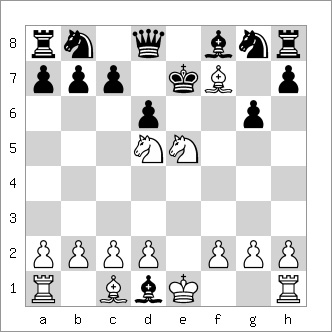 |
| Position after 7. Nd5 # |
lever - see "pawn break." |
light-square bishop - the bishop on a light square in the initial position. |
light-square weakness - the inability to control a group of light squares, usually due to loss or exchange of one's light-square bishop and/or pawn chains on dark squares. Hans Kmoch named this condition "leucopenia" in his classic Pawn Power in Chess (David McKay, 1959). |
line - an unobstructed rank, file or diagonal which provides access for a queen, rook or bishop to move or threaten a target. An "opening line" is another name for an opening variation. |
Lolli's Mate - a checkmate named after Italian player and theoretician Giambattista Lolli (1698 -1769.) Lolli's Mate consists of maneuvering a queen to infiltrate a weakened fianchetto pawn formation, attacking the king proximally, protected by an advanced pawn. Loss or exchange of a fianchettoed bishop results in a weak-square complex which the opponent can exploit with a mating attack. |
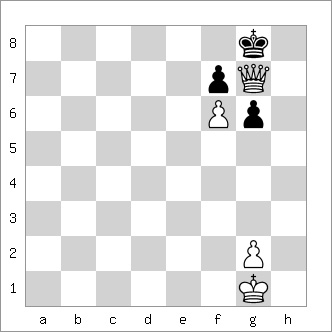 |
long diagonals - the two central diagonals of the chessboard, a1 - h8 and a8 - h1. |
Lucena (Luis Ramírez de Lucena, 1465 – 1530) - a Spanish chess player and author of Repetición de Amores y Arte de Ajedrez con 101 Juegos de Partido, published in 1497. A composed study (unfortunately named "Philidor's legacy" at a later date) was included in Lucena's book: |
| Philidor's Legacy "rr4k1/6pp/2Q5/3KN3/q7/8/8/8 w - - 0 1" |
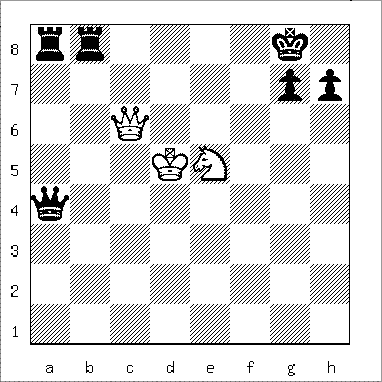 |
| White mates in 5 |
1. Qe6+ Kh8 2. Nf7+ Kg8 3. Nh6+ Kh8 (3... Kf8 4. Qf7#) 4. Qg8+ Rxg8 5. Nf7#. (see smothered mate .) |
Lucena Position - the winning position players with the pawn (can be any pawn except a rook pawn) aim for in a KRPvsKR endgame. It is huge in endgame theory and named after Lucena, even though it did not appear in his book (see previous entry.) The position was first published in 1634 by Alessandro Salvio, (1570-1640) a strong Italian chess player and author of two books on chess; his "Il Puttino" contains the famous rook and pawn ending known as the Lucena Position. |
| Lucena position "4K3/4P1k1/8/8/8/8/3r4/5R2 w - - 0 1" |
 |
| White to move and win |
1. Rg1+! The first step is to drive the enemy king two files away from the pawn. 1... Kh7 (not 1... Kf6 ? 2. Kf8 and the pawn queens.) 2.Rg4! The other key to the Lucena strategy, beginning the process of "building a bridge." 2... Rd1 (or 2... Kh6 3.Kf7 Rf2+ 4.Kg8 Re2 5.Rg7 Re1 6.Kf8 Re2 7.Rf7 Kg5 8.e8=Q Rxe8+ 9.Kxe8 Kh5 10.Rg7 Kh4 11.Kf7 Kh5 12.Kf6 Kh4 13.Kf5 Kh3 14.Kf4 Kh2 15.Kf3 Kh1 16.Kf2 Kh2 17.Rh7#) 3.Kf7 Rf1+ 4.Ke6 Re1+ 5.Kf6 Rf1+ Alternatives also lose: |
(a) 5... Re2 6.Rg5 Kh6 7.Re5 Rxe5 8.Kxe5 Kg5 9.e8=Q Kg4 10.Ke4 Kg5 11.Qf7 Kh6 12.Qg8 Kh5 13.Kf5 Kh4 14.Qg4#. |
6.Ke5 Re1+ 7.Re4 ! White completes the "bridge," preventing endless checks. 7... Rxe4+ 8.Kxe4 Here we see how crucial was 1.Rg1+! Without it, Black's king would still be on g7 and he could play ... Kf7, catching the undefended pawn and drawing. 8... Kg6 9.e8Q+ Kf6 10.Kf4 Kg7 11.Kf5 Kh7 12.Kf6 Kh6 13.Qg6# 1-0. |
luft (German "air") - the strategy of creating an escape square for a castled king, normally to prevent a back-rank mate. |
| [top] |
M |
"magic square" - In K+P endings, a system for determining how to gain the distant opposition. The solution is to create a hypothetical rectangle in which both Kings will occupy corners and all four corner squares will be the same color as the square the opposing King now occupies. This sounds a bit complicated but with a little practice becomes second nature. It is certainly simpler (and less prone to error!) than trying to count up all the different pathways the two kings might traverse. |
major pieces - queens and rooks, sometimes referred to as the "heavy pieces." |
mate - abbreviation for checkmate. |
mate-in-N moves - a type of chess problem where the solver is told how many moves are needed to force a checkmate. |
material - the chessmen, also called force. The opposite are positional (non-material) factors like space, time, quality of pawn structure and king safety. |
mating attack - a sequence of forcing moves with the goal of checkmating the enemy king. Mating attacks which don't end in checkmate often result in loss of material and/or weakening of position for the defender. |
mating net - a sequence of forcing moves that will result in checkmate against all possible defenses. |
Max Lange Mate - a checkmate named after German master and problem composer Max Lange (1832-1899.) The mate consists of queen and bishop utilizing a weak square complex to attack the enemy king. |
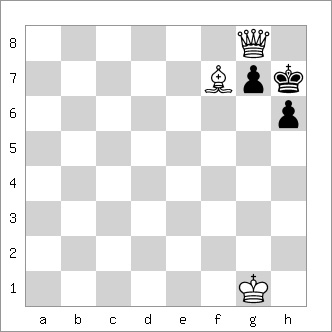 |
middle game - occurs when development is mostly completed: some pawns have advanced, some or all of the minor pieces are off the bank rank and (usually) the king has castled. Middle game play can be quiet maneuvering or violent tactics, and frequently features involvement of the heavy pieces (queen and rooks.) It is characterized by attack and defense, maneuvering and an attempt by both sides to further their own plans and disrupt those of the opponent. Combinations, sacrifices and mating attacks most often occur in the middle game. |
minor piece - a bishop or knight. |
Minor Piece Mate - a checkmate that occurs when several minor pieces coordinate to effect mate without support of the heavy pieces. |
 |
minority attack - advancing a pawn wing minority against the enemy's pawn wing majority, with the intent of opening lines and/or inflicting structural weakness on the majority. |
mobile pawn wing - is a formation of connected wing pawns that are free to advance. Such a group is a positional advantage because its advance may seize space, spearhead an attack, create a passed pawn etc. (see "off-side majority", "passed pawn", "lever.") |
mobility - is a positional factor that is often difficult to quantify. The theoretical mobility of the pieces underlies the table of relative values. However, players constantly need to assess the actual mobility of the pieces, both their own and their opponent's, in the position at hand. One way to determine mobility is to count the number of squares you control in your opponent's half the board, and vice versa, and note any difference. A better way, but more time-consuming, is to count every square on the board that you control, and every square that belongs to your opponent. There will also be "free" squares that neither side yet controls, and "dead" squares which neither side can ever control. A player controls a square if he (1) occupies that square and his piece or pawn is not en prise, or (2) can move a piece or pawn to that square without losing it. The difference in White's and Black's totals will indicate who has the greater mobility. One can also compare (square counts) the mobility of one piece vs. another. Does it make sense to trade an outpost knight that controls 6 squares for an enemy bishop that controls only 2 squares? Probably not, unless removing that bishop is key to a successful attack or setting-up a winning endgame. |
Morphy's Mate - a checkmate named after American master Paul Morphy (1837-1884.) The mate consists of the enemy king trapped in a corner, confined long-distance by a rook on the adjacent file and checked long-distance by a bishop. A pawn of the same color as the king blocks the only flight square. |
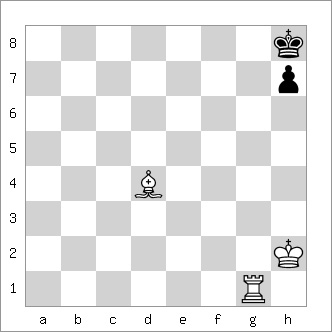 |
| [top] |
N |
NAG (Numeric Annotation Glyph) - 116 symbols composed of a dollar sign character ("$") followed by one or more digit characters, used to annotate chess games before PGN became standardized. Each NAG has a specific meaning within categories such as move, position and time comments. |
notation - the system for recording the moves of chess games. There have been several notation systems throughout the history of the game. Today, the universal notation system is Algebraic Notation, abbreviated AN (see also Descriptive Notation, or DN.) |
| [top] |
O |
off-side majority - is a wing majority of pawns on the side of the board away from the castled enemy king. Such a majority is most dangerous in king and pawn endings because it can force a passed pawn and the enemy king must travel across the board to try to stop the passer. |
open file - a file on which there are no pawns of either color is said to be "open." Control of an open file counts as a positional advantage. Control is most often effected by placing a heavy piece on the open file. Occupation is not necessarily control if the opponent can likewise move a heavy piece onto the file. |
open game - Openings which begin 1.e4, e5 are classified as open games. Because white has the ready-made pawn levers d4 or f4, exchanges inevitably occur and lines of attack are opened (compare semi-open, closed and flank openings.) |
open position - one or both center files are open due to captures or pawn exchanges, with plenty of open lines for the queens, rooks and bishops. |
opening - The opening is the first few moves of a chess game, characterized by the fight for control of the center and completion of development: moving as few pawns as possible in order to get the minor pieces off the back rank and onto good squares and getting the king castled. Over the centuries, distinct patterns of pawn formations and piece deployments have been given standardized names; compendiums of Master games and analyses for each of these openings constitute opening theory (see ECO codes.) |
opening lines - Same as opening variations. |
opening preparation - is the practice of identifying weaknesses in a future opponent's opening repertoire, and/or the systematic study of opening variations and transpositions, to discover "TN's" to surprise a future opponent. Today's players are greatly aided by chess engines and games databases in their opening preparations (see "prepared variation", "database".) |
opening repertoire - a limited number of openings a player specializes in and prefers to play. Many players have at least four, two openings for White plus a Black defense against 1. e4 and another against 1. d4. Others rely on flank openings exclusively, playing some form of the King's Fianchetto (g3 and Bg2) as white, the King's Indian/Benoni/Pirc/Robatsch (... g6, ... Bg7) as black. |
opening theory - the accumulated body of best master games and analyses for all the openings and their sub-variations. Theory is constantly changing and it's a constant effort for the strongest players to stay "au courant." Opening innovations are called TN's (theoretical novelties.) If successful, these new moves replace older lines; if unsuccessful, the moves are documented in the literature as inferior. Theoreticians also resurrect old, discarded lines with new analysis and the cycle repeats itself. |
Opera Mate - the checkmate takes its name from the game Paul Morphy won against Duke Karl of Brunswick and Count Isouard, played at the Paris Opera in 1858. A king on the back rank is attacked by a rook protected by a bishop. A pawn (or piece) the same color as the king blocks the only flight square. |
 |
opposite-color bishops - due to exchanges, a position where one side has a light-square bishop, the other side a dark-square bishop, or vice-versa. In the middlegame, opposite-color bishops may provide attacking chances due to a weak-square complex (absence of queens or the bishop that controlled those squares.) In a typical bishop and pawn ending, opposite-color bishops are notoriously drawish (see also "weak square complex".) |
opposite-wing castling - When one side castles king-side and the other side castles queen-side, we have a position with opposite wing castling. Such a position will almost always involve sharp play as each side tries to keep the wing on which they are castled closed, while trying to open files to the enemy king on the opposite wing. |
opposition and "the opposition" - When the two kings are directly opposed on a file, rank or diagonal with the required one empty square between them, they are said to be in direct opposition. The king whose turn it is to move loses the opposition, i.e., must give up control of one or more squares to the opposing king. Obtaining the opposition is the key to the basic checkmates and most K+P endgames (see also triangulation, corresponding squares, reserve tempo, distant opposition, and zugzwang.) |
OTB (over-the-board) chess - tournament chess in which the opposing players are physically present, as opposed to chess played by correspondence (postal mail, telegraph, email or server.) |
outpost (outpost square) - An outpost is a piece positioned on an advanced (5th, 6th rank) square, supported by a pawn and sheltered from attack by enemy pawns. A piece on 4th rank is not likely to be an effective outpost. Knights and rooks are the usual pieces to serve as outposts, although any piece except the king can do so. An outpost square is an advanced square which is suitable for occupation by a piece. Typically, a hole in the enemy pawn formation creates a suitable outpost square. |
outside passed pawn - a passed pawn on one of the wings. Such passers are especially dangerous in king and pawn endings if the opposing king will require many moves to reach the pawn/the promotion square (see also "better King position", "counting squares" and "off-side majority.") |
overloaded or (over-worked) piece - a piece which is burdened with defense of multiple units and/or key squares. Such a piece is often the target of an attack because it cannot move or be exchanged without causing checkmate or a catastrophic loss of material. |
overprotection - a term coined by Aron Nimzovich in My System, his seminal work on chess strategy and position play. Overprotection is the placement of additional pieces to support key squares or outpost pieces, thus discouraging attacks against those points, as opposed to waiting for an attack and then trying to defend (see also "prevention," "centralization," "the isolated QP," "restraint," and "blockade.") |
| [top] |
P |
passed pawn or "passer" - A passed pawn is any pawn whose forward progress is unimpeded by opposing pawns. A passer is dangerous because of its potential to reach the 8th rank and be promoted to any other piece except the king. Pawns are typically promoted to queen, hence the incorrect but commonly-used term "queening" a pawn (see "under-promotion".) The defender must keep a passed pawn under constant surveillance, either occupying its stop square with a piece (see "blockade",) or preventing its advance by controlling the square(s) in front of the pawn from a distance with pieces (see "restraint", "blockade.") |
pattern recognition - a learned ability to recognize recurring types of positions and to apply the appropriate strategic or tactical solutions. Pattern recognition is an important skill, useful in the opening, middlegame and endgame. |
patzer (German "patzen", to bungle) - a weak player. |
|
pawn break - a pawn is advanced to break open a blocked pawn formation. Subsequent pawn exchanges insure some files will become open or half-open, and/or additional pawns will be free to advance. The attacker thus obtains more space for his pieces. Hans Kmoch calls such moves "levers" in his Pawn Power in Chess (1959), because they "pry open" the enemy pawn formation. |
| [top] |
pawn center a formation of one or more pawns placed on one or more central squares is called a pawn center. The chess openings are classified according to their typical pawn formations. Due to the hypermoderns influence, pawn centers include the c- and f- pawns in the extended center (16 central squares.) |
pawn chain - when two or more pawns of the same kind are connected on a diagonal, the formation is called a chain. Pawn chains frequently are less mobile, often leading to locked or closed positions if enemy pawns are chained on the adjacent diagonal. An advanced chain extending into enemy territory exerts a cramping influence on the enemy, taking away squares needed for maneuvering and thus reducing his space. A chain is most vulnerable at its base. |
pawn formation or pawn structure - is a key element of chess strategy. Pawn structure in the initial or starting position is the best it can be. A phalanx (pawns side-by-side) controls all the squares before it, and is free to advance if a pawn is attacked, thereby defending it with pawns immediately to the rear. As the game progresses, however, compromises must be made in order to develop, seize control of key squares and obtain open lines for the pieces. This can result in a host of pawn weaknesses such as distortion or dispersion (pawns no longer defend one another) and permanent weaknesses which the enemy may attack: doubled even tripled pawns, isolated pawns, pawns backward on the open file, immobilized pawn chains and so forth. Because pawn movement is limited and slow compared to the other pieces, pawn formations tend to endure from the opening phase on into the middle game and sometimes even the ending. Each opening has a characteristic pawn formation which often determines the appropriate strategy for both sides (see "pattern recognition".) |
pawn island - one or more pawns separated from the others by one or more open files. Such pawns are weak and often the target of an attack (see also "hanging pawns".) |
pawn majority - numerical superiority of pawns on a wing, typically a 2:1 or else a 3:2 majority. It is also possible to have a central majority. A qualitative pawn majority is one which is healthy: mobile and not handicapped by backward, doubled or isolated pawns. In a K+P ending, it is able to force a passed pawn because the opposing pawn formation is crippled or outnumbered. |
"Pawn on 4 vs Pawn on 3" - a pawn center where white has one center pawn on his 4th rank, black has one center pawn on his 3rd rank and each side possesses one half-open center file. The central formation is either p(e4) vs p(d6,) or p(d4) vs p(e6.) Many opening variations produce such formations; one example is 1. e4 e5 2. Nf3 d6 3. d4 exd4 4. Nxd4 Nf6. It can also occur with black having the pawn on d5 or e5, white's pawn on d3 or e3. The player with the more advanced center pawn enjoys a slight space advantage and freer development of his pieces; the 4 vs 3 center confers a small positional advantage. |
pawn phalanx - two or more adjacent pawns of the same color on the same rank. |
pawn race - when both players are pushing their passed pawns toward the 8th rank, it often appears the pawns are "in a race" to be promoted. In actuality, players have likely predetermined the square counts and the ensuing tactics after promotion. |
pawn sacrifice - the deliberate loss of a pawn for non-material or positional factors, and/or a direct attack against the enemy king. |
pawn storm (or "pawn roller") - an attack spearheaded by advancing two or more adjacent pawns is called a pawn storm. The objective is to drive back defenders and/or open lines of attack through exchanges. |
PGN (Portable Game Notation) - the standardized system of recording chess games used by online databases and chess software. A pgn game score consists of a set of headers containing information about the game (event, site, date, players, result, ECO code etc.) followed by a section containing the numbered moves in algebraic notation. Some game scores also contain annotations, offset from the moves by pairs of curly braces. Example: |
[Event "Amsterdam"] |
[Site "Amsterdam NLD"] |
[Date "1971.??.??"] |
[Round "?"] |
[Result "1-0"] |
[White "Gligoric, Svetozar"] |
[Black "Langeweg, Kick"] |
[ECO "D80"] |
1. d4 Nf6 2. c4 g6 3. Nc3 d5 4. Bg5 Ne4 5. Bh4 c5 6. e3 Qa5 7. Qb3 Nc6 8. Nf3 cxd4 9. exd4 Bg7 10. cxd5 Nxc3 11. bxc3 Bxd4 12. Rc1! {Black had overlooked this zwischenzug which wins a piece.} 1-0 |
Philidor, François-André Danican (1726 – 1795) - a French composer and renowned chess
player. In 1749, Philidor published his famous book l'Analyse du jeu des Échecs (Analysis of the Game of Chess.) It was the first
systematic presentation of how to play the middlegame, presenting many of the positional elements today's players attribute to Nimzovich.
By 1871, the book was widely read and had gone through multiple editions, also translated into Italian, German, Russian and English. Philidor
was the first to realize the importance of pawn play in chess and his famous edict "the pawns are the soul of chess" is known by every chess
player. He demonstrated an important drawing technique in the K+R+P vs K+R endgame, known today as the Philidor position. |
Philidor Position (R+P endgame) - this drawing technique can succeed only when the attacking king and pawn have not reached their sixth rank. Black keeps his king in front of the pawn and his rook on his third rank (hence the alternative name "third rank defense,") to prevent the white king from reaching that rank. If White does choose to advance his pawn to its sixth rank, then the king obtains shelter from lateral checks. At this point Black must move his rook to the seventh (or eighth) rank and begin checking the white king from behind. |
| Philidor position (R+P) "8/4k2R/1r6/5K2/4P3/8/8/8 b - - 0 1" |
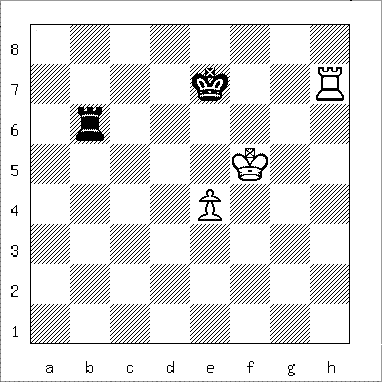 |
| Black to move and draw |
1... Ke8! 2.e5 Ra6 3.e6 Ra1! 4.e7 Rf1+ 5.Ke6 Re1+ etc. 1/2-1/2. White cannot escape checks by the rook; if the white king strays too far, ... Re1 followed by ... Rxe7 draws, or if white plays Kh6, then ... Rh1+ followed by ... Rxh7 followed by ... Kxe7 is a draw. |
| Philidor Position (Q vs R) |
| "4Q3/6rk/5K2/8/8/8/8/8 b - - 0 1" |
 |
| Black to move and lose |
If 1. ... Kh6 2. Qf8 and the rook is lost. If 1. ... Ra7 2. Qh5+ Kg8 3. Qg4+ Kh7 (... Kh8 4. Qc8+ Kh7 5. Qh3+ transposes) 4. Qh3+ Kg8
5. Qg3+ Kh7 (not ... Kh8 6. Qb8+ wins the rook) 6. Qh2+ Kg8 7. Qg1+ wins the rook. Or if 1. ... Rg1 2. Qe4+ Kg8 (or ... Kh8) 3. Qa8+ Kh7 4. Qa7+ wins the rook, but not 2. ...
Kh6 3. Qh4#. |
pieces - loosely, the chessmen; specifically, all the chessmen except the pawns. |
Pillsbury's Mate - a checkmate named after American master Harry Nelson Pillsbury (1872-1906,) consisting of a rook checking on the open g-file, and the only flight square controlled by a bishop on the long diagonal. The king's remaining adjacent squares are blocked by its own pieces and pawns. |
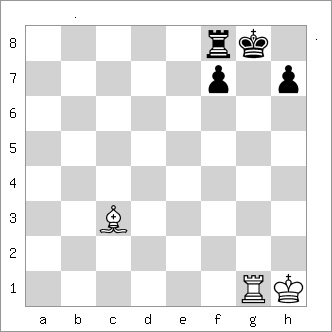 |
pin - when one piece shields another piece of higher value from attack it is said to be pinned. Only the queen, rook and bishop, which attack in straight lines, can pin an enemy piece. If such a piece shields the king from attack, it is called an absolute pin as the rules prohibit a player from putting his own king into check. |
pitfall - another term for trap. |
plan - a sequence of moves that will achieve a player's strategic goal(s.) Plans should be based on a careful assessment of the position (see "analysis of position".) Players must be flexible, modifying their strategy and/or adapting their plan to ever-changing conditions. Every move changes a position, even if only slightly. |
"poisoned pawn" - an en prise pawn whose capture leads to material gain but dire consequences such as loss of time, a piece out of play or unexpected counter-play by the opponent. |
position - the situation on the chessboard at any point in time is the position. The term is also applied to each player's situation, the number and placement of his forces, the space he controls, the safety of his king, his prospects, etc. We often hear players make assessments like "my position is bad" or "I stand a little better." |
position play - is characterized by concentration on strategic objectives, such as repairing weakness in one's pawn structure, establishing an outpost or exchanging a weak piece for the opponent's well-placed piece, as opposed to combination play or mating attacks. The two types of play are not mutually exclusive, however; one can rarely mount a successful attack from an inferior position, nor can we say that sound combinations or successful mating attacks are anti-positional. |
positional elements - the characteristics of chess positions which occur frequently and are
evaluated as positive and negative. To play "positionally" means a player attempts to exploit those elements in which he holds an advantage,
and to eliminate or at least minimize those that are disadvantageous. The majority of positional elements have to do with pawn structures,
squares associated with pawn formations and their influence on piece mobility. |
post mortems (Latin "after death") - Analytical sessions that take place after tournament games. Both players discuss the game and attempt to find the reason(s) why someone lost, or the reasons why a certain variation was (or wasn't) played, etc. (see also "skittles room.") |
postal chess - correspondence chess in which moves are exchanged via letter or postcard. Postal chess was the dominant form of correspondence play, from the middle ages until the 1990's (see "server chess"). |
prepared variation - opening variations, transposition sequences and theoretical novelties (TN's) developed secretly by a player for use in a future tournament. The surprise value of a prepared variation can be great, often the key to winning one or more games until an adequate counter is developed. Players carefully analyze their rivals' opening repertoires, looking for weaknesses or preferences that can be exploited. |
prevention (Greek "prophylaktikos") - "prophylaxis" is the term used by Nimzovich for prevention, a fundamental concept of positional play. Prevention is the over-all strategy of curtailing an opponent's territorial expansion or, if the opponent's position is cramped, stopping any freeing pawn moves (see "restraint," "pawn break.") |
priyome (Russian "associated technique or maneuver") - Russian term for recurring positions and the associated maneuvers to exploit such positions (see "pattern recognition".) |
problem (chess problem) - a composed position, or a position taken from an actual game, with some directions and/or hints for the solver (see puzzle.) |
promotion - when a pawn reaches its 8th rank it must be promoted, to any piece of its same color except the king. The pgn notation symbol for "promotes to" used to be "=" or "/", followed by the symbol for the piece, as in 37.g8=Q or 37. g8/Q. Today the move is simply 37. g8Q (see also "under-promotion".) |
prophylaxis - Term used by Nimzovich in his "My Sytem" to explain the long-term benefits of over-protection. By placing additional pawns and pieces where they defend key squares and outposts, such redundancy discourages the opponent from attacking these potential targets.(see also "over-protection".) |
protected passed pawn - A passed pawn still chained to another pawn of its own kind is called a protected passed pawn, and is frequently a winning endgame advantage. Because it is passed and therefore cannot be attacked by a pawn, the defender must sacrifice a piece to capture it (and probably its defender pawn as well.) At the least, the defender's piece is tied-down to preventing the passed pawn's advance. |
provisional rating - A temporary rating based on an estimate of the strength of a player. A provisional rating becomes an established rating based on performance versus other players in the system, after a specified time interval and/or a specified number of games have been completed (see "rating".) |
pseudo-sacrifice - a temporary sacrifice in a forced sequence of moves that will recover the initial investment of material. Also called a "sham" sacrifice. |
puzzle - chess puzzles (chess problems) are one and the same, positions presented as a challenge for solvers. A problem tells the solver which side has the move and the objective, such as "Black to move draws" or "White to move mates-in-four." Some even include hints. Published problems give credit to their composers, and are often based on real games; by convention, positions taken from actual games give credit to the players, the event and year. Some problems do not resemble real games at all, with multiple sets of doubled or tripled pawns, six queens and so forth. Novice players are advised to ignore such compositions as they do nothing to further pattern recognition. |
| [top] |
Q |
|
queen-less middlegame - positions where the queens have been exchanged. Amateur players are often observed ruining their positions in an effort to avoid the exchange of queens. |
queen-side - the a,b,c and d-files make up the queen-side of the chessboard. |
quiet move - see also "waiting move," "tempozug". |
| [top] |
R |
rank - a horizontal row of squares. Ranks are numbered 1-8 from white's side of the board, 8-1 from black's perspective. |
rating (rating system) - A chess rating is a probability estimate of a player's likliehood to win or draw vs. another player rated by the same formula. In general, a higher rating indicates the stronger player and so many players are obsessed with their rating. The only valid use of ratings is to insure equity in pairings for tournament play. |
relative pin - when a piece is pinned to any other piece except a king, the pin is relative and a player may elect to move the pinned piece (see "pin," "absolute pin.") |
repetition (threefold) - one of the 5 ways a chess game may be drawn. |
reserve tempo - a move, typically a pawn move, which places the enemy king in zugzwang. A reserve tempo move is useful for seizing the opposition when the enemy king cannot otherwise be forced to give way. |
restraint - another fundamental concept of positional play. Restraint is the placement of pieces and pawns to discourage (by threat of capture) the advance of enemy pawns. Pieces can also be restrained, although the effect is likely to be temporary. |
Reti's Mate - a checkmate named after Hungarian master, author and endgame composer Richard Reti (1889-1929,) consisting of a king hemmed in by its own pieces and pawns, checked by an enemy bishop protected by a rook of the same color. |
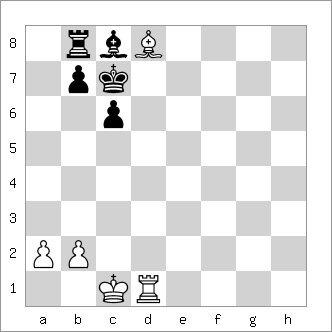 |
reverse salient - a group of 3 connected pawns of the same color, with the middle pawn one square behind the other two. |
|
rook lift - moving the a- or h-pawn to the 4th rank, then developing the rook to the 3rd rank, with potential centralization of that piece along the 3rd rank. Used as an alternative method of development when movement of the rook along the first rank is obstructed and/or prevented by enemy pieces. Some consider any Rook move two squares up from the first rank and then across the third rank to constitute a "Rook lift." |
"rook(s) on the seventh" - occupation of a square on the 7th rank by a rook is counted as a positional advantage because it usually threatens one or more indefensible pawns. Two rooks on the 7th are sometimes referred to as "pigs on the seventh" because of their tendency to devour undefended pawns and pieces, and also frequently initiate a mating attack. |
"rule of the square" - in pure king and pawn endings, the number of squares between a passed pawn and the 8th rank (including the square the pawn occupies) forms one side of the "square;" the same number of squares horizontally toward the enemy king form the other side of this "square." If the enemy king is within the square or, having the move can enter the square, then the king can catch an unescorted passed pawn and prevent its promotion. If both kings are in the square, then whether the pawn can be promoted depends on which side holds the opposition with respect to the promotion square. |
Rules of Chess - same as the Laws of Chess. The body of formal statutes which define the game of chess and how it is to be played, maintained by FIDE (Federation Internationale des Echecs") the world governing body for chess competitions. Additional rules pertain to the chess board, sets and clocks, player etiquette, tournament competitions and playing conditions. Some rules for otb chess do not apply to correspondence chess, and vice-versa. |
| [top] |
S |
sacrifice (or "sac") - is the deliberate surrender of material in exchange for other compensation. A true sacrifice does not entail guaranteed recovery of material (see pseudo-sacrifice, sham sacrifice.) |
salient - a group of three connected pawns of the same color, with the middle pawn one square in front of the other two. A salient which projects into the opponent's half the board confers a positional advantage, taking away space from the defender. |
Scholar's Mate - (also known as "Student's Mate") a checkmate named for such an obvious trap only a school child would fall for it. The mate involves the attack on black's f7 square (or white's f2 square) by a bishop and queen. |
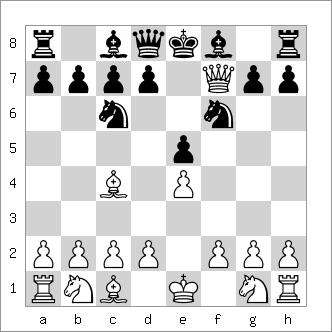 |
"see-saw" combination - So named for the back-and forth motion of the piece creating successive discovered checks (see "windmill".) |
semi-open game (also half-open game) - 1.e4 openings where black responds with moves other than 1 ... e5. Pawn exchanges frequently result in half-open files rather than open files, hence the name. |
server chess - correspondence chess games played on a web server. The advantages of server chess over postal and email play are many, including automated time keeping, illegal move prevention, online record keeping (no need to maintain a separate gamescore) and automatic reporting of results. Since moves are entered via mouse click in a GUI (graphical user interface, or 2-D board and men) there is no need for old style position recorders or even a chess set. Some sites require the downloading and installation of proprietary or else third-party client-side gui's, while others (such as I.C.C.F.) provide a server-side interface. Chess servers do not allow illegal moves to be entered. Unlike postal or email chess, one cannot lose a game due to a "recording error" in transcribing moves. Chess servers also provide continually updated crosstables for players to check standings, and PGN game scores may be downloaded after a specified number of games have been completed. |
seventh rank - is the opponent's second rank, often populated with pawns which are vulnerable to attack by the heavy pieces. (See "Rook on the 7th.") Occupation of the 7th rank by major pieces is frequently the basis for a mating attack. |
sham sacrifice - is a move sequence in which sacrificed material will be recovered by force; not a true sacrifice (see sacrifice, pseudo-sacrifice.) |
simplification - after gaining an advantage in material or pawn structure, the technique of judicious piece exchanges to reach a "won ending" is called simplification. Some authors use the term "liquidation." Such activity is, or should be purposeful, not just mindless "wood chopping." |
simul (as in simultaneous exhibition) - a popular venue arranged so a large number of players
can take on a chess celebrity, typically a Master or even Grandmaster. Traditionally, the Master has white in all games. Tables are arranged in
a large rectangle, with the Master inside, moving from board to board until all games are concluded. The Master plays his next move, and may
elect to play several moves in blitz fashion before moving on. A player should wait and make his next move when the Master steps to his board;
if a player is still thinking and not ready to move, he should so indicate when the Master comes to the board. When a game is concluded, all the
pieces are pushed to the center of the board. Amateur players consider it a success if they hold the Master to a draw, let alone win the game. |
| [Event "Kujoth Lecture and Simul"] |
| [Site "Decatur (Forsyth), IL"] |
| [Date "1982.06.20"] |
| [Round "?"] |
| [White "Kujoth, Richard"] |
| [Black "Honn, Jerry"] |
| [Result "0-1"] |
| [ECO "B80g"] |
1. e4 c5 2. Nf3 d6 3. d4 cxd4 4. Nxd4 Nf6 5. Nc3 a6 6. f3 e6 7. Be3 Be7 8. Qd2 Bd7 9. g4 e5 10. Nf5 Bxf5 11. gxf5 Qc7 12. Rg1 g6 13. fxg6 hxg6 14. Bh6 Nbd7 15. Be2 Qc6 16. O-O-O O-O-O 17. Rg2 Nb6 18. Bg7 Rh7 19. Bxf6 Bxf6 20. Nd5 Nxd5 21. exd5 Qc5 22. Rg4 Rxh2 23. Rc4 Qxc4 24. Bxc4 Rxd2 25. Rxd2 Bg5 26. Kd1 Bxd2 27. Kxd2 Rh8 28. Be2 Rh2 29. Ke3 f5 30. c4 Kc7 31. b4 b6 32. a4 a5 33. bxa5 bxa5 34. Bd1 Kb6 35. f4 Rh3+ 36. Kf2 exf4 0-1 |
sitzfleisch (German "to sit"+"flesh") - the ability to endure sitting at the chessboard for an extended period of time in OTB play. |
skewer attack - placing a piece so that it attacks several enemy pieces all in a line. Typically the enemy can move only one of the threatened units to safety. |
skittles - informal play. A skittles room is a designated area, separate from the main playing room, where players and kibitzers may gather for analysis or casual games between rounds of a tournament. Too frequently, the term is incorrectly pronounced (and spelled) "skiddles," probably by the same people who refer to a knight as a "horse," a rook as a "castle" and the game of chess as "chest." |
smothered - a piece that is trapped or immobilized by the edge of the board and/or other pieces of its own color. Such pieces are extremely vulnerable to capture by a hostile knight. |
Smothered Mate - a checkmate that occurs when a king is immobilized by its own pieces and pawns, has no flight squares, and is checked by an enemy piece, most typically a knight. |
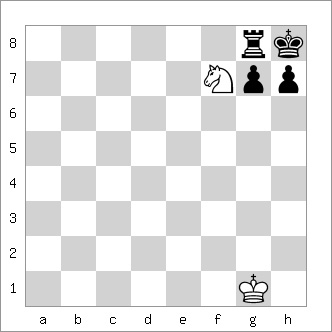 |
solver - someone who devotes time and effort to working out solutions to chess problems. Many enthusiasts have little or no interest in tournament play but derive great satisfaction from solving and/or composing chess problems (see "composition", "puzzle") |
space - another key strategic element in chess (along with force, time, pawn structure and king safety.) Space is the number
of squares controlled and available for your pieces and pawns. An advantage in space tends to dissipate over time and is best utilized in middle game play, maneuvering your
forces for an attack. The defender, with less space, often has difficulty shifting his forces to defend weak points in timely fashion. Various methods have been used to quantify
a space advantage; all involve counting squares. |
"spectators" - undeveloped pieces which stand on their original squares when the game has concluded. Failure to develop all the pieces is a common mistake by beginners. Leaving pieces undeveloped is tantamount to giving your opponent odds - you need to be a very strong player indeed to do that. The term is also sometimes applied to a piece locked out of play by the pawn configuration (see "bad bishop".) |
square(s) - the 64 divisions of the chessboard. Squares of the chessboard alternate in two colors and form patterns such as ranks, files, diagonals and color complexes. |
stalemate - the position where a player whose turn it is to move is not in check but he has no legal move by any of his pieces or pawns. A stalemate is scored as a draw. |
Staunton pattern - A Staunton pattern chess set is a particular design of chess pieces and the only style permitted in an official competition (as pictured below:) |
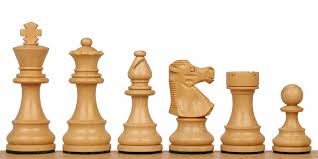 |
Tournament chess sets are made of wood or plastic; in the better quality sets, the pieces are also weighted and have felt under the bases. Hint: do NOT bring your prized civil war generals, aztec gods or star wars chess set to an official tournament. |
Nathaniel Cook was the original developer who patented his design in 1849. This style of set was first manufactured by Jaques of London; the firm still produces wooden chess sets of the highest quality. The chessmen are named after British chess master, author and publisher Howard Staunton (1810-1874). |
stop square - the square in front of a passed pawn. Occupation or control of such a square by enemy forces prevents the pawn's advance (see also "blockade".) |
strategy - is the development of a plan appropriate for the position at hand. Strategy is based on the analysis of position. In general, an advantage in force or pawn structure indicates end game play, while advantage in time or space indicates middle game play. Of course, if the opponent compromises his king's safety, an attack on the king (if possible) is indicated. |
swindle - an unsound trap or sacrifice made by a player with an inferior position.
It can only succeed if the opponent fails to discern the threat. |
| Vandenburg - Buckendorf |
| Twin Falls (Idaho Champ.) 1960 |
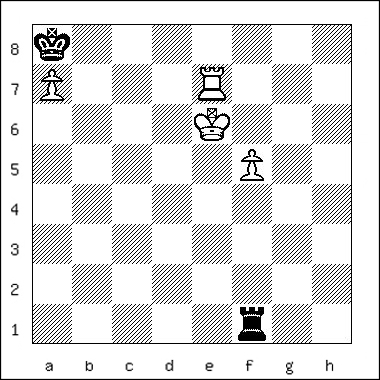 |
Faced with a dead lost ending, Black continued 62. ... Rxf5 (hoping for 63. Kxf5 ??, an immediate stalemate draw) 63. Re8+ !! and now Black must get his check out of check. Whether 63 ... Kxa7 or ... Kb7, White can safely play 64. Kxf5 with an easy K+R vs K win. |
symmetrical openings - variations where black "mirrors" white's moves. Theoretically such play will always result in an "even" or drawish position, but sooner or later one side will "break" the symmetry with a move that cannot be mirrored. Players should be prepared for an opponent "playing for a draw" with this strategy, working out in advance when and where to deviate from symmetry to gain an edge. |
| [top] |
T |
tabiya (unknown origin, possibly Arabic) - the key positions in standard openings, from which sub-variations branch. The position after 1.e4 c5 2. Nf3 d6 3. d4 cxd4 4. Nxd4 Nf6 5. Nc3 a6 would be the tabiya for the Najdorf Sicilian. |
tablebase (endgame tablebase) - a computer database accessed by a chess engine containing all possible moves of an endgame, and whether the outcome is a win for one side or a draw. Some engine/gui packages include limited databases such as Gaviota or Syzygy; the most popular tablebases are Nalimov (limited to six total pieces and pawns, White and Black) and Lomonosov (limited to seven total pieces and pawns.) Hard drive storage requirements for tablebases are huge and exceed the capacity of typical pc hard drives; users can access them online. |
tactics - a sequence of forcing moves that results in attainment of an objective, either winning material or improving one's position. Standard tactical motifs include the pin, fork, skewer, battery, discovered attack, discovered check, double attack, double check, deflection, desperado, interference, king hunt, mating attack, pawn storm, x-ray attack, overloaded defender, under promotion, windmill, blocking, back rank mate, zugzwang, zwischenzug, triangulation, clearance and decoy sacrifices. |
Tarrasch Rule - In rook and pawn endings, the rule states a rook belongs behind a passed pawn, either its own or an opponent's passer. (Note: this is valid strategy but is not an actual rule of chess.) |
technique - the technical knowledge of how to win a "won game." Basic checkmates and successful mating attacks require technique, as does simplification into a "won" ending and correct application of endgame theory to the position itself. |
tempo - one move or turn. Moving the same piece twice, to reach a square it could have reached in a single move, is a loss of a tempo. Such inefficiency in the opening almost always hands the opponent an advantage in time (provided he has used his extra move efficiently, such as developing another piece.) Paradoxically, "losing" a move may be the key to a winning strategy in the end game (see triangulation.) Sometimes it is difficult to assess who has gained or lost a tempo. Plural ("tempi"). |
tempozug (German "time move") - if his position cannot be improved, a player tries to make a waiting move that doesn't weaken his position (see also "waiting move," "quiet move."). |
theoretical novelty (abbreviated "TN") - When a player disrupts a known opening sequence by playing an unexpected move, if not a blunder then it is referred to as a "TN". Whether a "TN" is incorporated into "book" opening theory, or relegated to a footnote, depends on whether strong players successfully adopt the move in their games. Sometimes a discarded "TN" takes on a new life; fresh analysis may resurrect it from the archives (see also "book opening", "opening theory".) |
threat - any move having the potential to win material or weaken the opponent's position is a threat. Experienced players try to prevent, or else neutralize, threats before they become a reality. The player who is able to accumulate multiple unanswered threats has the initiative and is able to control the course of the game. CJS Purdy, first World Corres. Champion, advised players to "look for moves that smite," meaning strong moves that threaten two or more things at the same time (see "bind", "initiative".) |
"three piece rule" - attributed to chess author Colin Crouch. The "three piece rule" states an attacker needs three pieces for a successful attack on the king, one to sacrifice and two to effect checkmate. (Note: this is not an actual chess rule, just a bit of "tongue-in-cheek" humor by author Crouch.) |
time - one of the key elements of chess. An advantage in time tends to dissipate and so a player who has gained several tempi must use these to maneuver his forces into an attack (see tempo.) |
 |
time clock - a mechanical or electrical device used in tournament play to enforce the time limit. While a player ponders his move, his own clock is running. After he makes his move on the board, writes the move down on his score sheet and punches his clock, it stops and the opponent's clock starts running. Typically, a player must complete a specified number of moves within a pre-established time limit or he loses the game (forfeits on time) regardless of the position on the board. |
time control (time limit) - in otb tournament play, a time control is specified as the number of moves each player must make within a period
of time, such as 40 moves in 90 minutes, with additional increments to apply until the game concludes. Time controls are used so games will finish in a timely manner
and pairings for subsequent rounds can be made efficiently. Time controls are typically enforced by means of a time clock. In blitz or
speed chess, time limits are extremely short, as in "10 seconds per move" or "5 minutes to complete the entire game." |
"time trouble" (German zeitnot) - in tournament chess, a situation where a player has a small amount of clock time remaining to make the required number of moves. This is troublesome because the player has little thinking time and must reply quickly each time his opponent moves. Time trouble usually results in weak play if not outright blunders. Tournament players must learn to manage the clock and avoid "time trouble." Bobby Fischer famously said when a player is in time trouble it isn't chess anymore. |
Top 3 - is an engine detection system in which each move of a chess game is compared with the top three move recommendations of a chess engine. Players whose moves exceed an allowable % of matching will be sanctioned in some manner by the organization. Various safe guards are built into the system, including exemption of opening "book" moves, getting a king out of check, recaptures, moves to prevent loss of material and forced mates. The rationale for safe guards is that most players would make such moves without the aid of a chess engine. CCLA incorporated Top 3 into its playing rules for games beginning in 2020. |
touch-move rule - in official chess tournament competitions, this rule compels a player to move whichever piece or pawn he touches first. There are no "take backs" in regulation play. Novice players must learn to first move their king two squares left or right, then place the rook on the other side of the king to complete the castling maneuver. |
transpositions - alternate move orders to reach a desired position. In the openings, transpositions are designed to catch an opponent off-guard and reach a position the opponent would avoid if a standard move order was followed. (See "book opening".) |
trap - the placement of pieces or pawns to entice an opponent into an unfavorable move or line of play. Traps rely on the opponent's failure to perceive the danger (see "swindle", "cheapo".) |
trébuchet (French term for "medieval catapault") - An endgame position where two Kings are on opposite
sides of a set of blockaded pawns. |
 |
Above is a true "trebuchet" position. The kings are in mutual zugzwang; whichever king is on the move must abandon his pawn to capture by the opposing king, which will then escort his own pawn to the promotion square, obtaining a queen and winning the game. |
The diagram below is often incorrectly described as a trebuchet or mutual zugzwang position, where the player with the move loses. Quite the opposite is true! Here, the King who can first attack the enemy pawn from the rear wins the enemy pawn and saves his own, thereby obtaining a queen (via pawn promotion) and winning the game. |
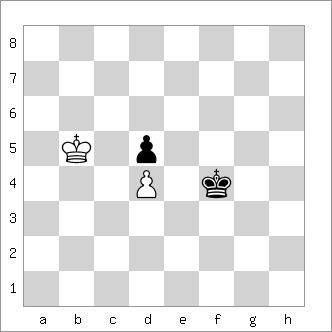 |
If White moves first, he wins: 1. Kc6! Ke4 2. Kc5 zugzwang - Black loses his pawn and the game. If Black moves first, he wins: 1. ... Ke3! 2. Kc5 Ke4 zugzwang - White loses his pawn and the game. |
triangulation - maneuvering a king to retain the opposition, or else obtain control of a critical square, in pawn endings. It is also referred to as "losing a move," so that the opponent ends up in zugzwang. Other pieces can also triangulate, as in queen vs. rook end games (see Philidor position - Queen vs Rook.) One side can gain an advantage if a pawn (or a piece) is free to move, thus breaking the impasse of kings in direct opposition. This is referred to as having a "reserve tempo." In more complex endings, both sides may have one or more reserve tempi; the player who exhausts his reserve moves first will lose the opposition. |
tripled pawns - three pawns of the same color on one file. This situation occurs as the result of captures. Tripled pawns are extremely rare, extremely weak and should be avoided if possible. They are unlikely to be part of a pawn group and therefore not supported by adjacent pawns. Some compensation may exist in terms of square control and possession of open or half-open files. In his magnus opus on the middlegame, Pawn Power in Chess (1959), Hans Kmoch refers to the tripled pawn as a "monster." |
| [top] |
U |
uncastled king - a king in the center can become the object of direct attack and is considered a serious positional weakness. Many gambit lines involve sacrifice of a pawn, sometimes a whole piece, just to prevent the opponent from castling (see "king held in the center"). |
unclear - positional evaluation which cannot determine if either side has an advantage. The consequences of material sacrifice, usually a pawn but sometimes "the exchange" or even a whole piece, for "positional considerations" are often unclear and a player must rely on intuition. The annotator's code for "unclear" is the ∞ symbol. |
under-promotion - selection of rook, bishop or knight instead of a queen when promoting a pawn. The rationale for under-promotion is to avoid creating a stalemate, or because the chosen piece will effect a quicker checkmate or win of critical material. See Pawn Promotion and Under-promotion for additional explanation. |
U.S.C.F. - the United States Chess Federation (USCF) is the official affiliate of FIDE and administers offical otb tournaments in the U.S.A. If games are "USCF-rated", then USCF rules apply. If games are "FIDE-rated", then FIDE rules must be followed. |
| [top] |
V |
values (of the chessmen) - are used as a guide to determine equal exchanges. The traditional "chart of relative values" fixes the value of a pawn = 1, knight or bishop = 3, rook = 5 and queen = 9. The value of the king is infinite, as checkmate of the king equals loss of game. However, in simplified endings, especially positions without queens, the king is an effective fighting piece with a 4.5 mobility value. Advanced players supplement these relative values with positional judgment, i.e., exchanging a minor piece for one or two pawns, a rook for a minor piece, etc. to obtain a positional advantage such as a strong outpost, control of a key file, a mating attack and so forth. (See also Table of Relative Values.) |
variation - may refer to a specific sequence of moves which are part of a formal opening, such as the Exchange Variation of the Queen's Gambit Declined. Variations may also be hypothetical sequences of alternative moves, commonly seen in the annotation of complete chess games (see "annotation," "opening line," tabiya.") |
visualization - the ability to "see" in the mind's eye a future position, or series of positions, flowing logically from the current one. Some players work forward from the present position, others visualize an ideal position and try to work backward to the present one. Average players are able to do this for short series ("if I go there, he replies this way, then I go here ...etc.") Gifted players can project long series of moves and also hold key positions in memory while they analyze side lines. Some players can visualize every piece, every square in successive positions (so-called "photographic memory",) while others only focus on key aspects of positions (see blindfold chess.) |
| [top] |
W |
waiting move - a move that isn't a capture or an attack. If a player determines he cannot improve his position, he may play a waiting move to make the opponent reveal his intentions. Such a strategy can cut both ways as a passive move may hand the initiative to the opponent. Also called a "quiet move" (see "tempozug.") |
weak square complex - a group of same-colored squares vulnerable to occupation or attack by enemy forces. The typical example is a player's pawns chained on squares of one color and his bishop of the opposite color lost or exchanged. Without the bishop, it is difficult to defend such a group of weak squares from incursion by enemy pieces (see "light-square weakness", "dark-square weakness" and "Lolli's Mate.") |
White - the player who has the white or light-colored chessmen. White always moves first in a game of chess. |
windmill - a combination based on a series of discovered checks and/or ordinary checks, usually involving a rook and a bishop, that wins a critical amount of material or effects checkmate. Sometimes referred to as a "seesaw combination." |
wing - the two or three contingent files away from the two center files (see also "flank", "opposite-wing castling".) |
"won" game or "won ending" - a "won" game is a position where one player's advantage in material or position is so great the opponent will normally resign. A "won ending" is an end game position in which the winning technique is documented in theory. However, in tournament games, the side at a disadvantage may not resign immediately if the superior side is in "time trouble" or the winning technique is complicated and/or lengthy (see "fifty-move rule" under drawn games.) |
"wood pusher" - chess jargon for an untutored player, from the old days when chess sets were primarily made of wood. |
| [top] |
X |
x-ray attack - a position where an attacking unit and its potential target (a piece or a square) are in line but obstructed by an enemy unit. |
| [top] |
Z |
zeitnot - (German for "no time") - Literally "out of time." Managing the time clock is a necessary skill, especially for otb players but corres. players can also get into time trouble. Losing on time is just as much a loss as being checkmated (see "time trouble".) |
zugzwang - (German "compulsion to move") typically occurs when all the moves available are "bad" moves, tangibly weakening the moving player's position (often from a draw to a loss, or from a win to a draw). Zugzwang most often occurs in the end game when the number of pieces, and so the number of possible moves, is reduced, and the exact move chosen is often critical. Zugzwang is very common in king and pawn end games, where it is frequently achieved through triangulation. Pieces other than the king can also triangulate to achieve zugzwang – e.g., a queen versus rook end game. |
zwischenschach (German "in between move with check") - a zwischenzug that is also a check. An overlooked zwischenschach has spoiled many a combination or a mating attack. |
zwischenzug - (German "in-between move") is a chess tactic in which a player, instead of playing the expected move (usually recapture of a piece the opponent has just captured with) first interposes another move, posing an immediate threat that the opponent must answer, then plays the expected move. Ideally, the zwischenzug changes the situation to the player's advantage, such as gaining material or avoiding what would otherwise be a strong continuation for the opponent. |
| [top] |